Iran: The Sham Trials and Horrific Public Hangings Have Started


The Truth About Reichsbürger’s Coup






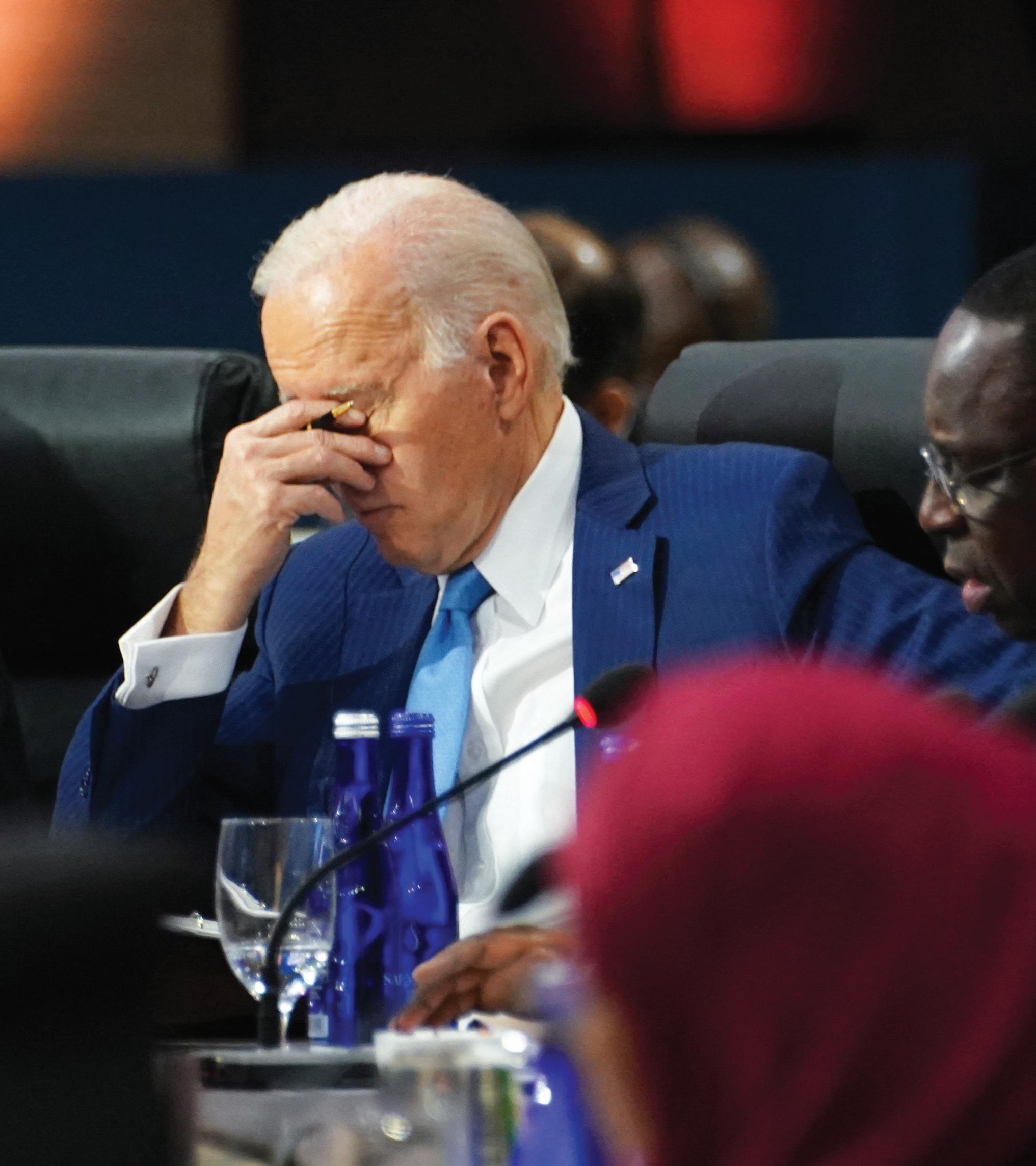

This week, Washington hosted a three-day summit under the title of “US-Africa Leaders Summit,” calling in forty-nine political leaders from Sub-Saharan and North Africa as well as the Commissioner of the African Union to discuss ways to revive and enhance America’s socio-economic partnerships with the continent.
A senior U.S. official told the press that “the summit is rooted in the recognition that Africa is a key geopolitical player and one that is shaping our present and will shape our future.”
In the Cover Story, Dalia Ziada writes about how the United States administration of President Biden is assertively pushing the reset button on its foreign policy in Africa. However, she said that America’s potential to outpace other regional and international competitors over the resources of the most fertile continent is still pretty limited.
In the Politics Section, Suzan Quitaz wrote about the execution of -23year-old Majidreza Rahnavard by the Iranian authorities last week.
In connection with ongoing nationwide protests entering their third month, Rahnavard was charged with “Moharebeh” and, after a sham trial, was hanged in a public execution in the north-eastern city of Mashhad.
Mizan news agency reported that Rahnavard was hanged in the presence of a crowd. It also posted a number of night-time photographs reportedly showing the execution, including a crowd of onlookers and an image of a man seen hanging from the cable of a crane.
In the Economy Section, Motasem Al Felou wrote about an agreement signed between Saudi Aramco and the government-owned Kuwait Gulf oil company on December 12 to develop the Durrah gas field, which is located in the Arabian Gulf, with a production of 1 billion cubic meters a day.
The Saudi-Kuwaiti move comes with another side of the story on the other side of the Gulf. Iran claims it has ownership rights over parts of the Durrah gas field and calls it Arash.
In the Sports Section, Sara Gamal wrote about Walid Regragui, Morocco’s coach, who was appointed only on August 31 - and when he was appointed, the shavedhead mastermind was mockingly dubbed «avocado head» by pundits in the northern African nation.
Despite the fact that Regragui was regarded as a nameless and inexperienced coach, one of Regragui›s most notable accomplishments has been reintegrating Chelsea›s Hakim Ziyech and Bayern Munich›s Noussair Mazraoui back into the squad after international exiles for both players, both of whom are now crucial to Morocco.
Read these articles and more on our website eng.majalla.com. As always, we welcome and value our readers’ feedback and we invite you to take the opportunity to leave your comments on our website.
A Weekly Political News Magazine www.majalla.com/eng
Editor-in-Chief Ghassan Charbel
The Editor Mostafa El-Dessouki
HH Saudi Research and Marketing (UK) Ltd


10th Floor Building 7 Chiswick Business Park 566 Chiswick High Road London W4 5YG
Tel : +44 207 831 8181Fax: +44 207 831 2310
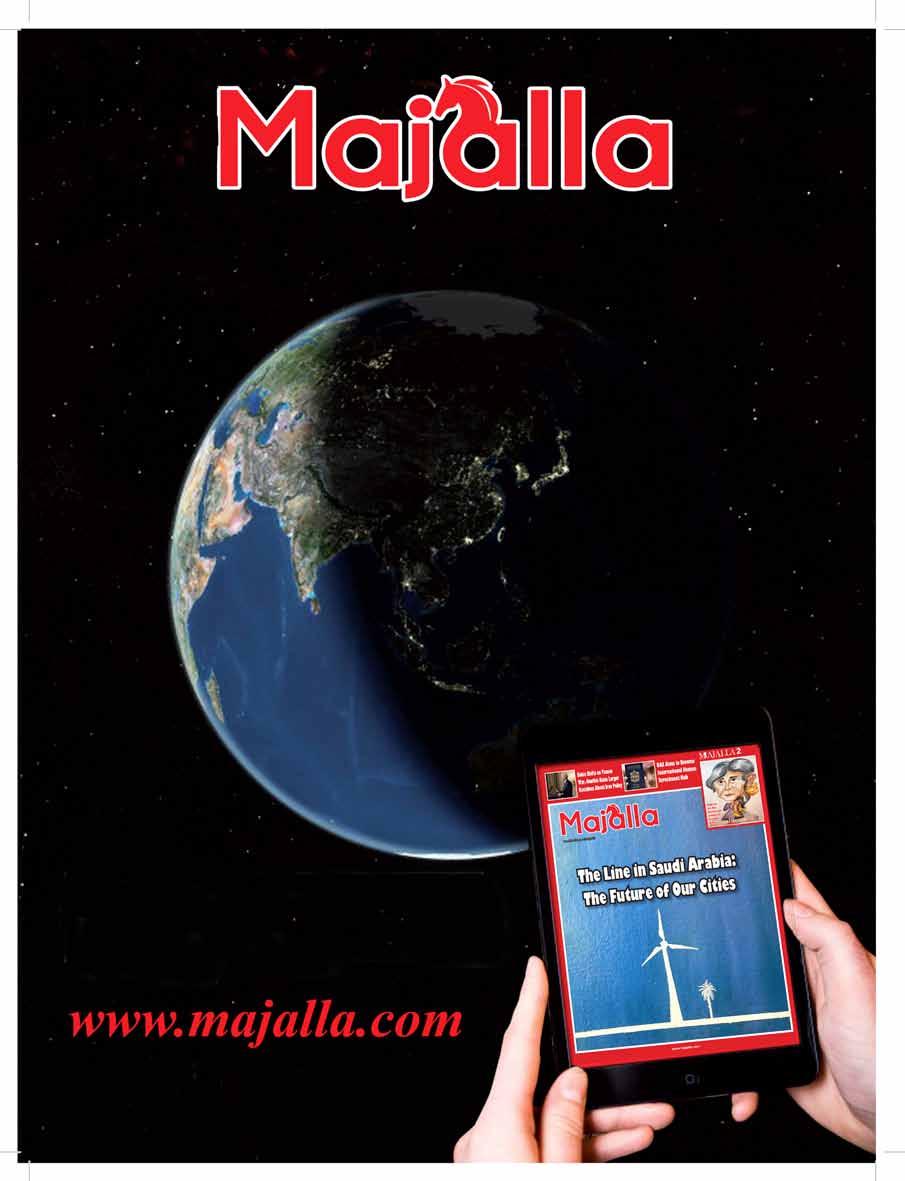
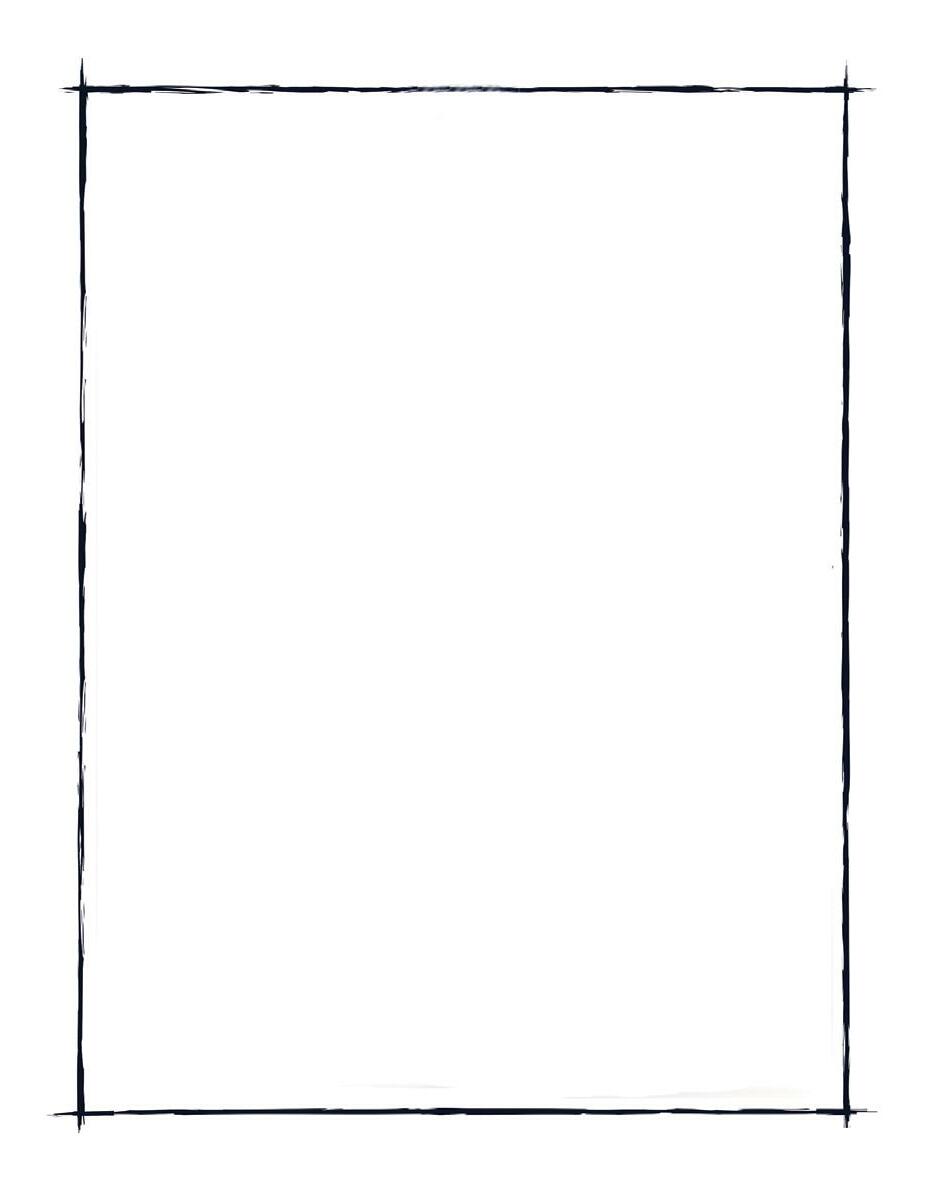

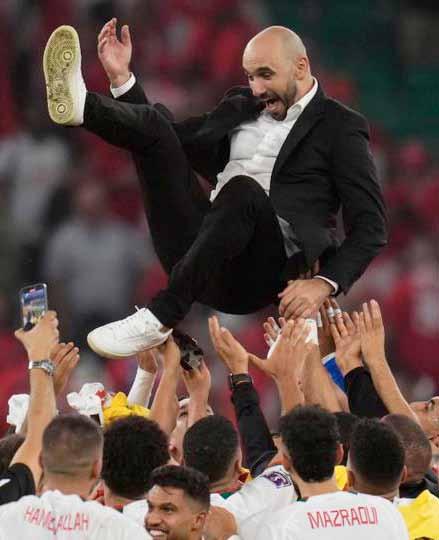


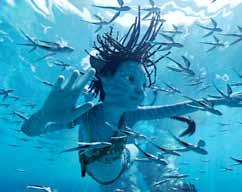

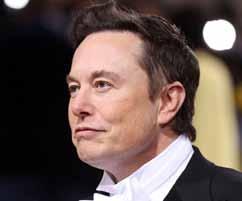
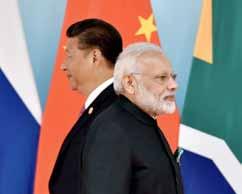





Artists of the academic folk dance ensemble «Nalmes» perform at the final concert of the year of Russian culture in Kyrgyzstan on the stage December 12 ,of the Kyrgyz Philharmonic in Bishkek, Kyrgyzstan The cross year of Kyrgyzstan - Russia is officially recognized as .2022 closed, the Minister of Culture, Sports and Youth Policy of Kyrgyzstan Altynbek Maksutov announced. EPA
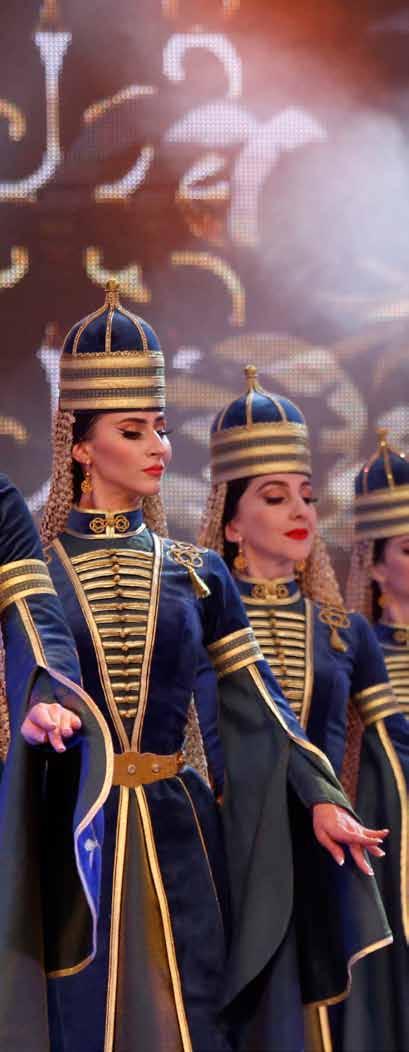
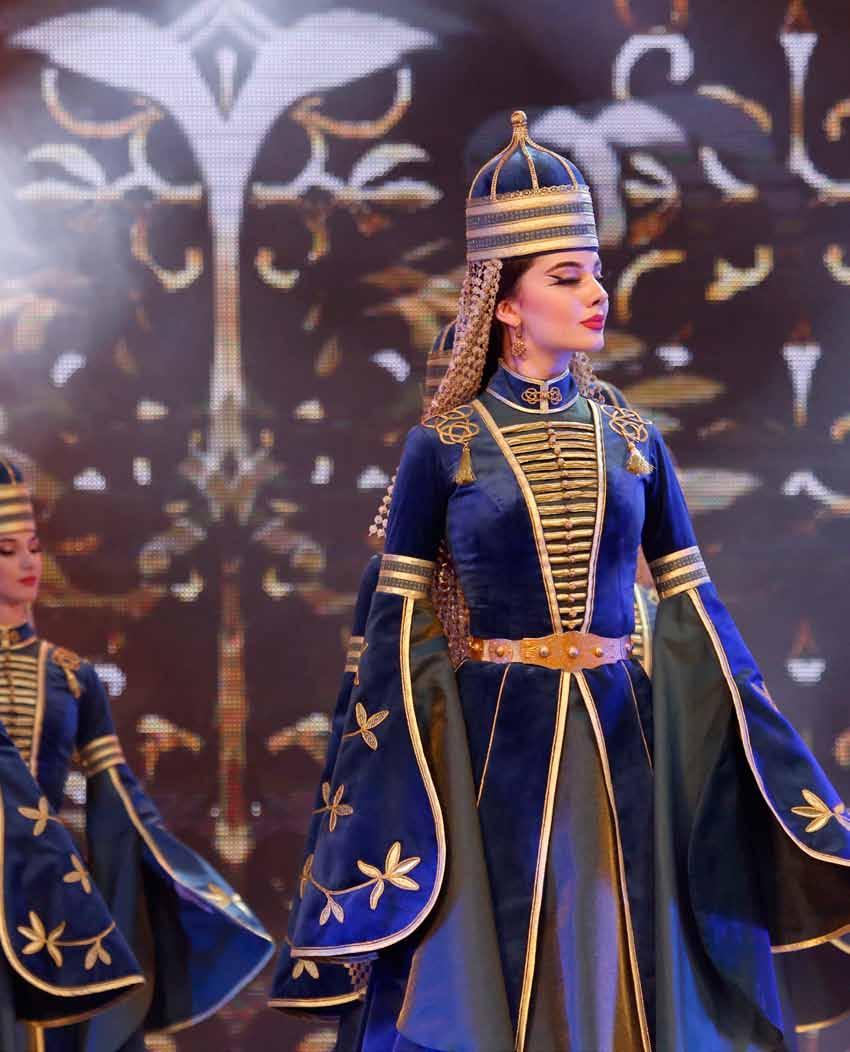
People enjoy the snow at Parliament Square in London, Monday, Dec. 12, 2022. Snow and ice have swept across parts of the UK, with cold wintry conditions set to continue for days. /AP



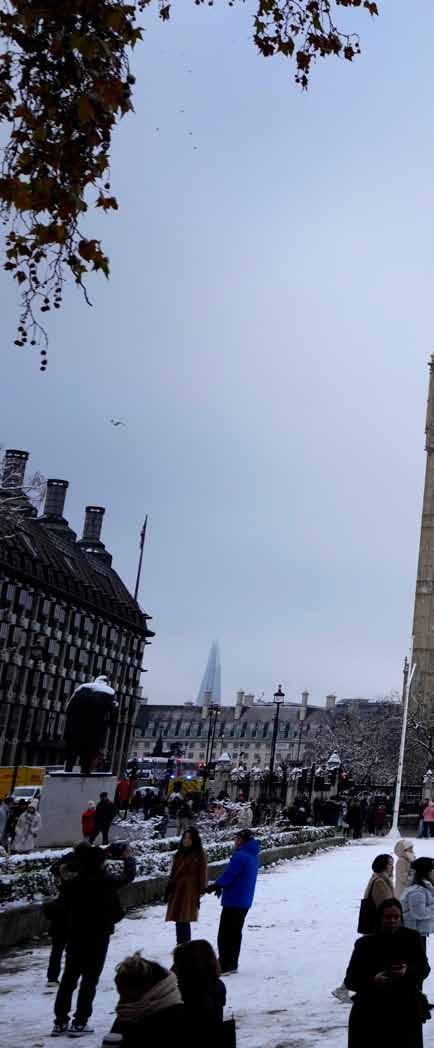


The amount of carbon-intensive mazut fuel oil Egypt uses in power stations has reached ve-year highs as it seeks to maximise the amount of natural gas available for export, data published by the electricity sector's regulator showed. The shift towards mazut, which is mostly produced in Russia, allows Egypt to generate electricity more cheaply and export more gas to alleviate an acute foreign currency shortage. Mazut's share of total power generating inputs reached 20.95% in October, data from the Egyptian Electric Utility and Consumer Protection Regulatory Agency showed.

An Irish soldier was killed on a U.N. peackeeping mission in Lebanon late on Wednesday when a convoy of two armoured utility vehicles travelling to Beirut came under small arms re, Ireland's defence forces said in a statement. Another Irish member of the United Nations Interim Forces in Lebanon (UNIFIL) is in a serious condition having undergone surgery following the incident, the statement said. Two other soldiers are being treated for minor injuries.

Saudi Arabia’s that all bets operational acting to shore “If Iran gets bets are o on-stage interview Conference
“We are in a region...you certainly look their own security,” Speaking about Arab-China Prince Faisal cooperation is “incredibly
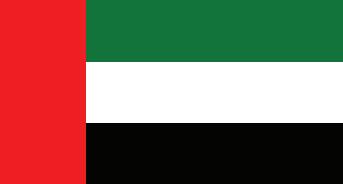
Arabia’s foreign minister said on Sunday bets would be o should Iran get an operational nuclear weapon, with Gulf states shore up their security.
gets an operational nuclear weapon, all ,” Prince Faisal bin Farhan said in an interview at the World Policy Conference in Abu Dhabi.
a very dangerous space in the region...you can expect that regional states will look towards how they can ensure security,” he said. about the GCC-China Summit and the Arab-China Summit that took place on Friday, Faisal said continuing to increase cooperation between the Kingdom and China “incredibly important.”

The leader of the United Arab Emirates made a surprise visit on Monday to Qatar as it is hosting the World Cup — his rst since leading a yearslong four-nation boycott of Doha over a political dispute that poisoned regional relations.
Three members of the Iraqi security forces were killed in an explosion north of Baghdad on Wednesday, Iraq’s military said.
The personnel were killed when an explosive device detonated during a security operation in the Khan area of the Tarmiyah district. A commander of the 59th Infantry Brigade and two others were killed, a military statement said.
Lt. Gen. Qais al-Muhammadawi, commander of Iraq’s ground forces, will lead an investigation in the area into the causes of the explosion, the statement added.

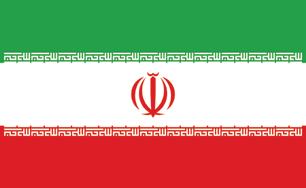
Iran executed a second prisoner on Monday convicted over crimes committed during the nationwide protests challenging the country’s theocracy, publicly hanging him from a construction crane as a gruesome warning to others.
The execution of Majidreza Rahnavard came less than a month after he allegedly fatally stabbed two members of a paramilitary force after purportedly becoming angry about security forces killing protesters.
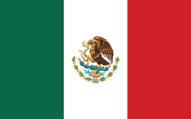
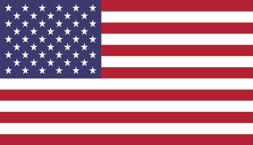
The Federal Reserve will deliver more interest rate hikes next year even as the economy slips towards a possible recession, Fed Chair Jerome Powell said on Wednesday, arguing that a higher cost would be paid if the U.S. central bank does not get a rmer grip on in ation.
Recent signs of slowing in ation have not brought any con dence yet that the ght has been won, Powell told reporters after the Fed's policy-setting committee raised its benchmark overnight interest rate by half a percentage point and projected it would continue rising to above 5% in 2023, a level not seen since a steep economic downturn in 2007.
An earthquake hit southwestern Mexico on Sunday causing tremors through parts of the capital, according to residents, but there were no immediate reports of damage.
The U.S. Geological Survey said the magnitude 6.0 quake struck 3 kilometers (1.9 miles) west-northwest of El Ticui in the state of Guerrero at a depth of 19.8 kilometers (12.3 miles).
Mexico City Mayor Claudia Sheinbaum said on Twitter a yover of the city had not yielded reports of damage.

German lawmakers said Monday they are digging deeper into an alleged coup plot uncovered last week when police detained dozens of people linked to the far-right Reich Citizens movement.
Prosecutors said the 24 Germans and one Russian detained last Wednesday are suspected of being members of, or of supporting, a “terrorist organization” that planned to topple the government.
movement.
President Volodymyr Zelenskiy hailed his dissolution on Tuesday of a Kyiv court as evidence Ukraine can ght to end a history of corruption and Russia's invasion at the same time.
"This story has drawn to a close," he said as he announced he had signed a law liquidating the Kyiv District Administrative Court, which Ukrainian anti-corruption authorities had compared to a criminal organization and whose chairman was hit with U.S. sanctions Dec. 9.
"But the story of reforms continues –it continues, even in the time of such a war," Zelenskiy said in his nightly video address.
Indian and Chinese troops su ered minor injuries in a clash in the Tawang sector of India's Arunachal Pradesh state on Dec. 9, the Indian army said on Monday, the rst such incident since the deadly clash between the two neighbors in June 2020.
When China's leaders gather this month to set next year's economic agenda, they will likely map out more stimulus steps, eager to underpin growth and to ease disruptions caused by a sudden end to COVID-19 curbs, policy insiders and analysts said.
In three days of closed-door sessions at the annual Central Economic Work Conference, President Xi Jinping and other top o cials are expected to discuss keenly anticipated growth targets, expanded scal spending on infrastructure and other programs, and the potential for more monetary easing.

The United States administration of President Biden is assertively pushing the reset button on its foreign policy in Africa. However, its potential to outpace other regional and international competitors over the resources of the most fertile continent is still pretty limited.
In mid-December, Washington hosted a three-day summit under the title “US-Africa Leaders’ Summit,” calling in forty-nine political leaders from Sub-Saharan and North Africa as well as the Commissioner of the African Union to discuss ways to revive and enhance America’s socio-economic partnerships with the conti-
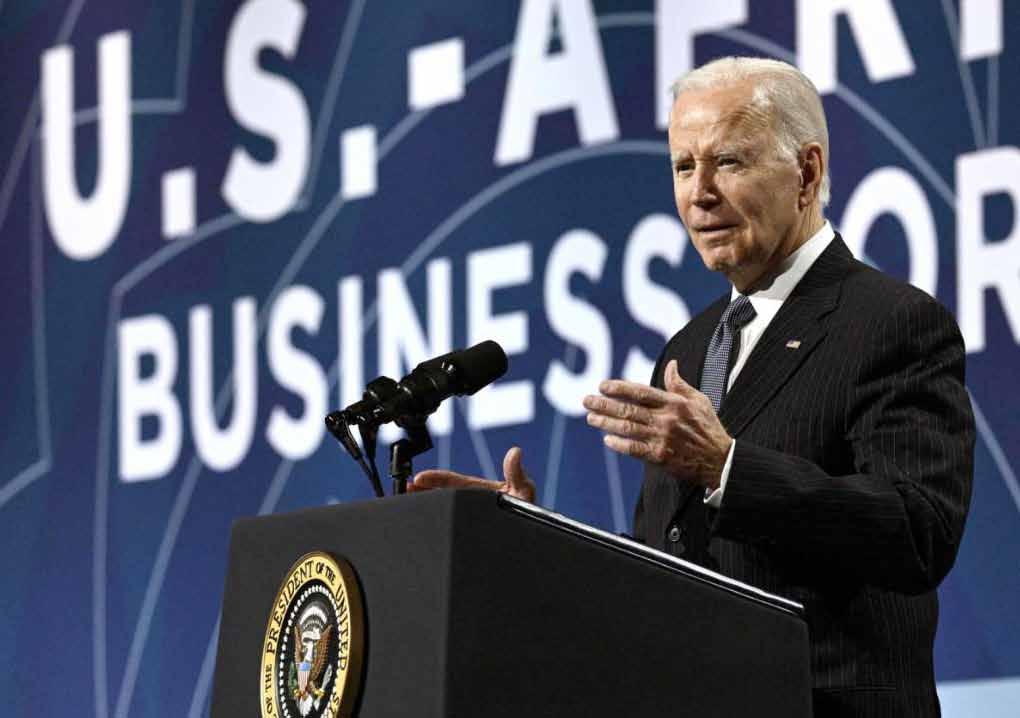
nent. A senior U.S. official told the press that “the summit is rooted in the recognition that Africa is a key geopolitical player and one that is shaping our present and will shape our future.” Indeed, Africa is a fertile continent with an unparalleled wealth of minerals and fuels. It is also home to 1.3 billion people, most of whom are young, offering an enormous market for lucrative business opportunities to foreign investors.
The overdue summit is the second episode of a historic meeting that former U.S. President Barack Obama held eight years ago, in August 2014, under the same title. The theme of the two summits and the agenda items are almost identical, but America’s geo-strategic standing and the surrounding global context are quite different. While the 2014 summit had prioritized discussions on civil society, good governance, and democratization, the current summit pushed these critical topics down the list after strategic economic partnerships, food security, and response to the climate crisis.
The Business Forum is the star of the show in this year’s US-Africa Summit. The Summit organizers dedicated a physical “Prosper Africa Deal Room” for American and African business tycoons, investors, and government officials to meet, discuss, and announce future business agreements.
The goal of the Deal Room is to “advance mutually beneficial partnerships that create jobs and drive inclusive and sustainable growth on both sides of the Atlantic,” according to the description of the Summit organizers. Yet, the real purpose of such a room, which has been live-streamed by top media outlets all day, is perhaps to show off in real-time the progress of US-Africa relations compared to America’s superpower competitors, especially China.
In the African domain, the United States is entering a new level of competition with several international and regional actors that already have sturdier economic and security partnerships in the fertile continent. On the top of this competitors’ list are China, Russia, Turkey, and two of the wealthiest countries in the Arab Gulf region, namely Saudi Arabia and the United Arab Emirates (UAE). Their collective power as pragmatic allies outweighs the power of the United States and Europe.
In the past few years, the UAE, as one example, emerged as a primary logistics hub for China’s Belt and Road Initiative in the Middle East and North Africa region and a host to more than six-thousand Chinese companies. In addition, China, Saudi Arabia, and the UAE have been running joint and parallel infrastructure and tourism projects in east Africa.
Last week, the first-ever Arab-China Summit was held in Riyadh. Chinese President Xi Jinping and a dozen of Arab leaders returned home after the summit with several economic and security agreements that some of them described
as a milestone for “high-quality” cooperation.
Unlike the United States, eastern superpowers do not tie security and economic cooperation with Arabs to improving human rights and governance conditions, which most Arab countries view as interference in domestic affairs. Likewise, most African countries, including those who yearn to establish solid alliances with the United States, find working with China much easier because it does not load agreements with political change provisions.
The fierce economic standoff between the West and Russia since the latter’s invasion of Ukraine in the spring is believed to be one of the key motivators behind convening the US-Africa Leaders Summit in Washington this week. After losing several of its best Arab allies to Russia and China, mainly because of inconsistent foreign policy moves in the past two years, the Biden administration is keen on winning over Africa to compensate for this massive loss.
That raises the question about what the U.S. administration can realistically offer to Africa to win this competition, especially in view of an absence of any collective African perception of what Africa could need from Washington that the other powerful competitors have not already introduced.
The United States has been the second top investor in Africa, after China, over the past decade (2010-2019), according to data from the “Swiss-African Business Relations Status Quo 2021” report. The distance between the Chinese and the American positions on the index compared to other countries on the top ten list, such as France, Turkey, and the United Kingdom, is as wide as eleven-thousand newly created jobs. Yet, the gap between China as the top investor and the United States in the second position is as large as six-thousand newly created jobs. China poured into Africa at least 27% of its foreign investments during that period.

In mid-December, Washington hosted a three-day summit under the title “US-Africa Leaders’ Summit,” calling in forty-nine political leaders from Sub-Saharan and North Africa as well as the Commissioner of the African Union to discuss ways to revive and enhance America’s socio-economic partnerships with the continent.
On the regional level, the report shows that the UAE is the only Arab country that made it to the top ten investors in Africa in the past ten years. UAE holds the 9th position on the index with 2,968 newly created jobs. That puts UAE above wealthy western investors like Switzerland, Spain, and Canada. In the coming decades, the UAE is determined to continue expanding its investments in Africa, especially in the countries of eastern and southern Africa. According to a white paper issued in October 2021 by the Economist Intelligence Unit (EIU) and commissioned by Dubai Chamber, the UAE held 88% (US$1.2 billion) of total investments by all Arab Gulf countries in Sub-Saharan Africa in the period between January 2016 and July 2021.
Turkey is another remarkable competitor that the United
States should monitor for its growing influence on Africa. Turkey is the fourth largest investor in Africa, after China, the United States, and France. The difference between Turkey’s investment power in Sub-Saharan African countries, compared to the power of European investors, such as France and Germany, is slightly a few hundred newly created jobs over the past ten years.
In 2020, the total trade volume between Turkey and Africa reached as high as US$25.3 billion, compared to a trading volume of US$20 billion between Africa and the entire continent of Europe. Most African imports from Turkey are textiles, furniture, electronics, steel, and cement. Meanwhile, Turkey made a direct investment of US$6.5 billion in the construction sector in Africa over that period.
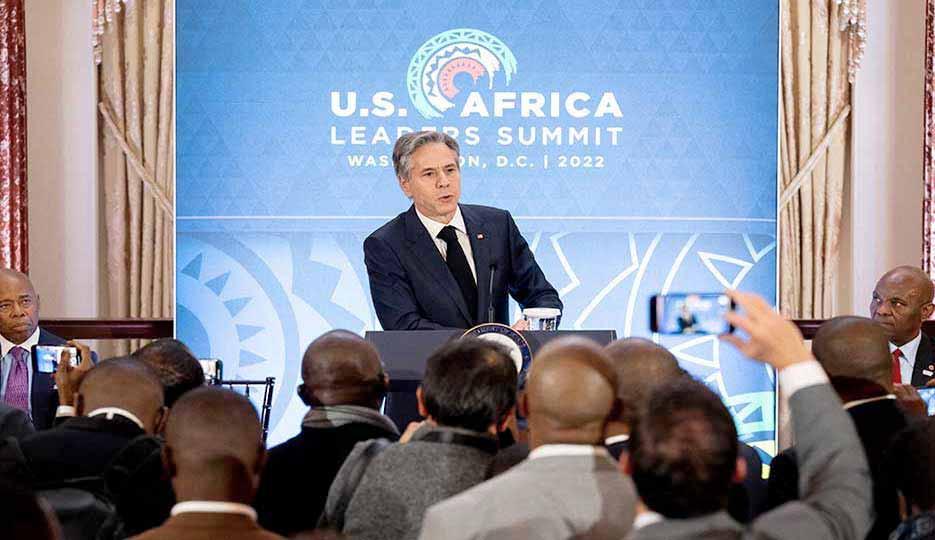
Nevertheless, Turkey’s political influence on Africa is much stronger than any other competitor, even China’s. That is basically due to the clever employment of the military diplomacy tool by the leadership of the Turkish Armed Forces to win over allies in a continent boiling over with a myriad of security threats, ranging from terrorism, border conflicts, and civil wars. This week, while the United States is hosting a summit for Africa, African military leaders are visiting the Turkish Minister of National Defense, Hulusi Akar, in Ankara to discuss cooperation and review military deals.
Turkey’s military diplomacy pattern is designed to create a double-layered bond of economic and security co-dependency with targeted countries that can hardly be broken once tied. This pattern was successfully applied in the long-term partnerships that Turkey established in the 1990s and early 2000s with pivotal countries in Asia, such as Pakistan and Azerbaijan.
Turkey’s indigenous defense industry is about to hit a selfsufficiency rate of 80% by the end of 2022. A market starv-
It’s Turkey, Not China!
The United States has been the second top investor in Africa, after China, over the past decade (2019-2010), according to data from the “Swiss-African Business Relations Status Quo 2021” report.
ing for arms and ammunition in Africa is one of the ideal destinations for Turkish military products. Today, Turkey is already exporting weapons to Morocco, Algeria, Tunisia, Sudan, Ethiopia, Somalia, and Kenya, and the list is expanding by the day. The African countries are particularly interested in the Turkish drones and helicopters, as well as technologically advanced electronic war systems that they can procure from Turkey for a relatively lower cost than the price of similar equipment from the United States, Russia, or even China.
In general, western powers are usually unlucky when it comes to competing against the eastern superpowers, or even regional actors, in the African continent. Europe’s vain quest to revive ties with Africa is an example that the United States should study and learn from. At least since 2020, Europe has been trying to redefine its relationship with Africa as a strategic partnership rather than a “donorrecipient” affair. The highlight of this effort was creating a new EU-Africa Strategy that encompasses a huge budget of thirty billion euros for social development projects in North Africa.
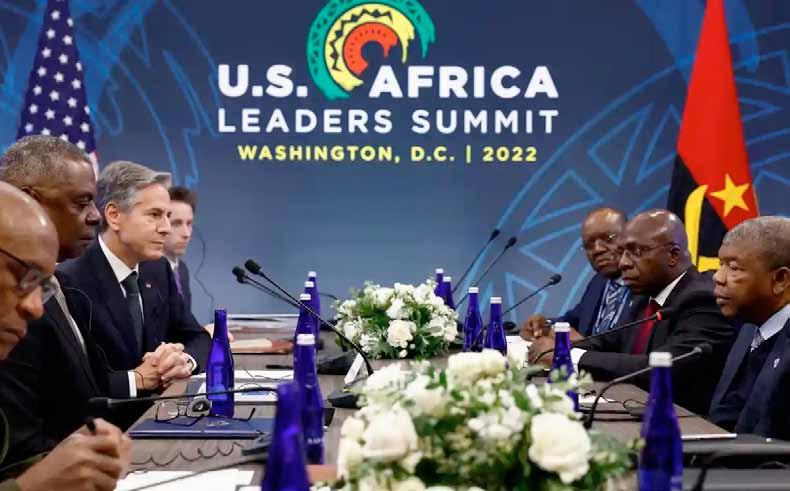
In early 2021, the European Council approved a proposal by the European Commission to establish the “New Agenda for The Mediterranean” to “relaunch and strengthen the strategic partnership between the European Union and its southern neighborhood partners.” Consequently, a new instrument titled “Neighbourhood, Development and International Cooperation Instrument” (NDICI) was issued to guide Europe’s policy in the Mediterranean. The NDICI set an investment recovery plan in targeted African countries with a budget of
seven billion euros for the period 2021-2027, with a promise to mobilize up to thirty billion euros in private and public investments over the next ten years. Europe’s urgent interest in regaining its long-lost influence in Africa is not new. For years, leading voices of major European collegiate bodies have been calling to strengthen the bond with Africa. However, the wide gap between Europe’s vision and Africa’s needs has blocked positive measures and tangible results. That is the core of the lesson that the United States needs to derive from Europe’s failed endeavors in Africa. Despite its proven sincerity to renew and foster ties with Africa, the U.S. administration may fail if it does not abandon its western perception of politics and business conduct for a while and try to look at Africa through African eyes.
The goal of the Deal Room is to “advance mutually beneficial partnerships that create jobs and drive inclusive and sustainable growth on both sides of the Atlantic,” according to the description of the Summit organizers.
On Monday morning of December 12, the family of Majidreza Rahnavard received a call from an Iranian official informing them that their 23-yearold son had been executed and was now buried in Behesht-e- Reza Cemetery in Mashhad.
In connection with ongoing nationwide protests entering their third month, Rahnavard was charged with “Moharebeh” and, after a sham trial, was hanged in a public execution in the north-eastern city of Mashhad early Monday morning. Mizan news agency reported that Rahnavard was hanged in the presence of a crowd. It also posted
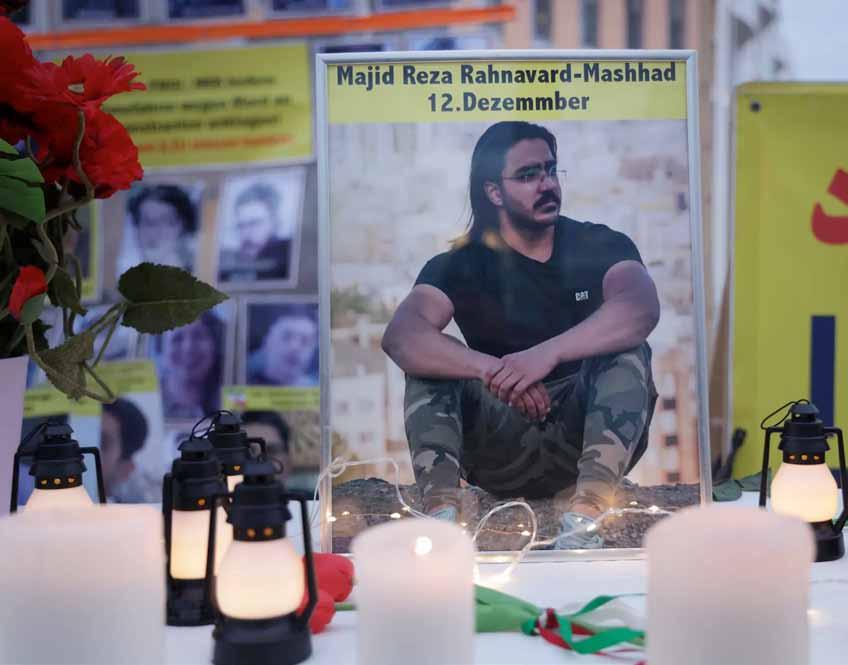
a number of night-time photographs reportedly showing the execution, including a crowd of onlookers and an image of man seen hanging from the cable of a crane.
1500tasvir, an opposition activist collective group, posted a tweet on Monday night of the execution stating that “The brutes of the Islamic Republic attacked Majidreza Rahnavard’s grandmother’s residence, arresting his uncle and brother for a few hours. They took away all the banners and flowers for the ceremony and then forcefully evicted the family from their own home.”
It should be noted at the outset that Moharebeh, means “waging war against God,” and it is a crime under Iranian law that is punishable by death. The crime of Moharebeh is defined as the act of committing violence or rebellion against the authority of God and the state, with the intention of undermining the social order or overthrowing the regime. The offense came into being when the Mullah-regime came to power in 1979 and this charge has since been levied against thousands of people. Human rights groups including Amnesty International have voiced their opposition and said it has been used by the Iranian authority as a tool to silence dissent. Many of those who have been charged with Moharebeh have been activists, journalists, artists, and other individuals who have spoken out against the regime or supported protests, as in the case of the 27-year-old Kurdish artist Saman Seydi also known as Saman Yasin. Saman was accused of Moharebeh by the Iranian “judiciary” and has now been sentenced to death. Diana Eltahawy, Amnesty International’s Deputy Director for the Middle East and North Africa, said: “The horrific public execution of Majidreza Rahnavard today exposes Iran’s judiciary for what it is: a tool of repression sending individuals to the gallows to spread fear and exacting revenge on protesters daring to stand up to the status quo. The arbitrary execution of Majidreza Rahnavard less than two weeks after his only court hearing lays bare the extent of the Iranian authorities’ assault on the right to life and their disregard for even maintaining a façade of meaningful judicial proceedings.”
According to state-affiliated media, Rahnavard pleaded guilty to stabbing and killing two security officers and injuring four others officers during an anti-government protest on November 17. Torture and staged confessions of political prisoners are
widely used in the Islamic Republic of Iran. Rahnavard’s trial is strictly textbook for a sham trial – within less than a month he had confessed to the charges, was convicted and executed. The cursory trial raises a lot of concerns about the perverted condition of Iran’s judicial system and the lack of fair trials and the rights to appeal. The Rahnavard case is also a clear illustration that the Iranian authorities are resorting to the death penalty as a weapon of political repression and as a cloak for murder.
Another important factor to highlight in Rahnavard case is that this young protester had no previous criminal convictions. This begs the question about how he could have managed to overpower 6 Basij officers from one of Iran’s most well-trained and feared paramilitary force, by stabbing two to death and wounding another four.

Days before Rahnavard’s execution, another young protester was executed by hanging. Mohsen Shekari is thought to be the first protester to be executed in connection with this latest round of Iran protests. He was hanged on Thursday, December 8. Shekari was arrested on September 25, and then convicted on November 20 on a similar charges as Rahnavard, namely, Moharebeh. He was sentenced to death at Tehran’s Revolutionary Court for allegedly blocking Sattar Khan Boulevard on September 25 during a protest in Tehran and also wounding a Basij security officer with a knife. Shekari’s court proceedings were held behind closed doors. These star chambers are a widespread practice in Iran where often political prisoners are not allowed to choose their lawyers, not afforded due process nor even to see the evidence laid against them. Often a confession is tortured out of them.
Commenting on the Shekari kangaroo court, Eltahawy said “the shocking way Mohsen Shekari’s
The brutes of the Islamic Republic attacked Majidreza Rahnavard’s grandmother’s residence, arresting his uncle and brother for a few hours.A photograph of Majid Reza Rahnavard stands on a table among candles during a demonstration by supporters of the National Council of Resistance of Iran outside the German Foreign Ministry in Berlin, Germany. Credit: GETTY
trial was fast-tracked through Iran’s judicial system without allowing him the chance of a meaningful trial and appeal process is yet another illustration of the fact that the authorities are resorting to the death penalty as a weapon of political repression. The clear aim is to instil fear among the
public in a desperate attempt to cling to power and end the popular uprising.”
Iran’s so-called “judiciary” is not an independent institution but receives its marching orders from the Mullah regime and Iran’s ruthless Islamic Revolutionary Guards Corps (IRGC) who had warned on December 5 that security forces would show no mercy towards “rioters, thugs and terrorists.” The IRGC also praised the judiciary for its stance on protests and encouraged it to act swiftly and decisively issue judgments against defendants accused of “crimes against the security of the nation and Islam.”
Nearly 20,000 protesters have been detained and, with the regime acting on its threats to swiftly execute “rioters, thugs and terrorists,” there is an imminent risk that more protesters are on their way to the gallows.
On December 12, Amnesty International reported that it had identified at 20 people at risk of executions linked to the anti-government protests. They include 11 people already sentenced to death, 6 individuals awaiting or undergoing trial on charges carrying the death penalty, and another 3 protesters “who have undergone trials on capital charg-
Activists display placards of Amini and recently executed Iranian demonstrator Mohsen Shekari in front of the Brandenburg Gate illuminated with the words ‘Woman, Life, Freedom’ in various languages, including Kurdish and Persian, in Berlin, on Tuesday. (John MacDougall/AFP/Getty Images)
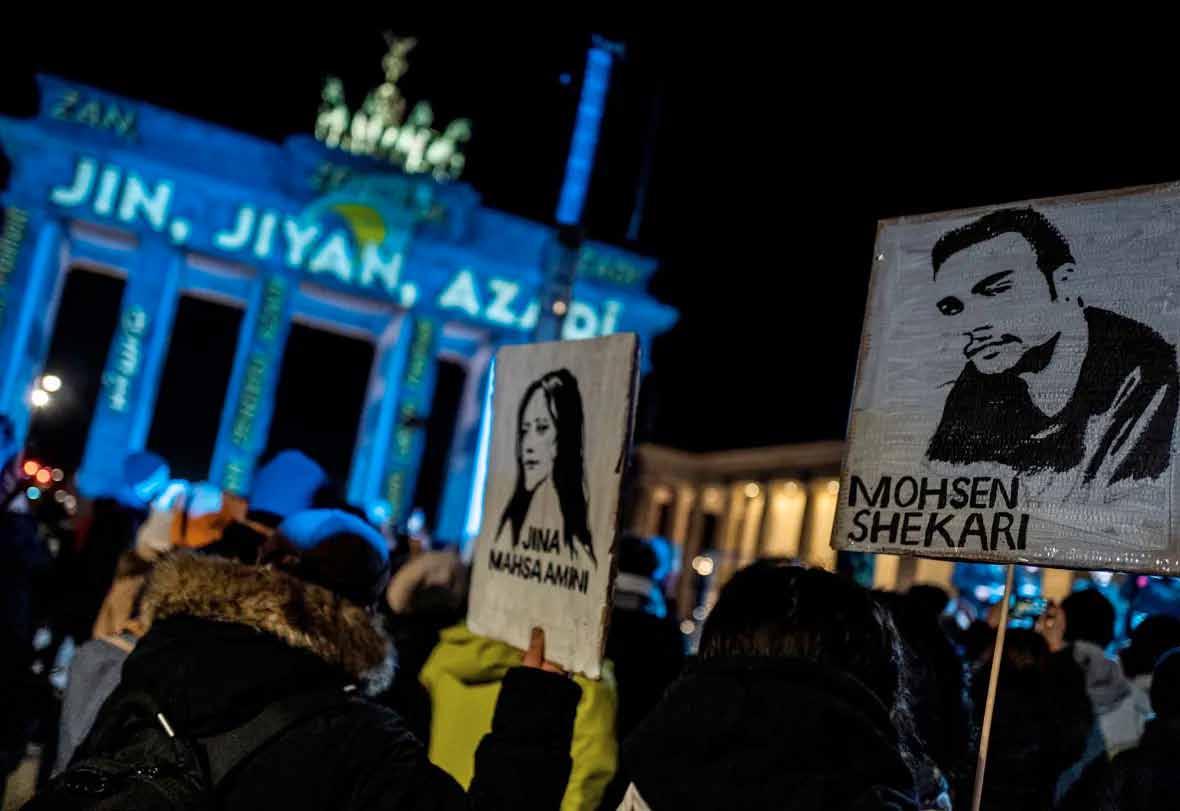
The horrific public execution of Majidreza Rahnavard today exposes Iran’s judiciary for what it is: a tool of repression sending individuals to the gallows to spread fear and exacting revenge on protesters daring to stand up to the status quo.
During a demonstration in Berlin on Monday, protesters carry posters of Majid Reza Rahnavard, 23, and Mohsen Shekari, 23, who was the first person involved in antigovernment protests to be hanged on Dec. 8. (Sean Gallup/Getty Images)

es and who are either at risk of being sentenced to death or may have already been sentenced to death, with no publicly available information on their status.”
Even before the current uprising, Iran had an alarming number of executions carried out annually. Amnesty International has written on its website that “The Iranian authorities have embarked on an execution spree.”
Diana Eltahawy said that “During the first six months of 2022, the Iranian authorities executed at least one person a day on average. The state machinery is carrying out killings on a mass scale across the country in an abhorrent assault on the right to life. Iran’s staggering execution toll for the first half of this year has chilling echoes of 2015 when there was another shocking spike.”
Eltahawy rightly referred to 2015 since in that year, from January to July, a staggering 694 people were executed. In commenting on this shocking figure, Mr. Said Boumedouha, Deputy Director of Amnesty International’s Middle East and North Africa Programme said, “Iran’s staggering execution toll for the first half of this year paints a sinister picture of the machinery of the state car-
rying out premeditated, judicially-sanctioned killings on a mass scale.”
Amnesty International just recently published the names of at least 20 people who have been handed execution orders. All were arrested in connection with the protests, one of those names is Saman Yasin.
Who is Saman Yasin?
Saman Yasin is at imminent risk of being executed. The 27 year old is on Amnesty International’s list of persons sentenced to death and awaiting execution. Saman is a well-known songwriter, composer and a rapper from Kermanshah and a resident of Tehran. Saman published a number of Kurdish protest songs with topics such as oppression of his people under the boot of the Iranian regime. On his personal Instagram page, he supported the Uprising and condemned the murder of Zhina Amini (Mahsa). His songs appealed to young Iranians from all ethnicities and social background.
On Sunday, October 22, IRGC officers came to his home and took him away. The Hengaw Organisation for Human Rights in Iran’s Kurdish region, writes “according to the available information, Saman Yasin has been subjected to severe mental
and physical torture during his detention.” Just a week after his arrest, on October 29, “Judge” Salvati at the Islamic Revolutionary Court in Tehran found him guilty on the charge of “war against God,” and the death sentence was officially announced to the family. Mohsen Shekari had his sham trial with the same puppet judge as Saman Yasin.
Hengaw continued, adding that “Yasin has been deprived of access to a lawyer since his arrest. That Saman Yasin was suddenly transferred from Evin Central Prison to Rajaei Shahr Prison in Karaj about two weeks ago, and this sudden transfer and the possibility of his death sentence being executed secretly have worried his family.”
The renegade regime’s killing spree is on full scale and intensifying, Majidreza Rahnavard and Mohsen Shekari are just two of many victims
who did not have a chance to defend themselves in Iran’s sham unfair and rushed so-called trials. Nearly 500 protesters have been murdered by the regime security forces and more will continue dying in the streets, in the detention centers and others will soon be hanged in the gallows.
In late November, Agnès Callamard, Amnesty International’s Secretary General, urged UN Human Rights Council member states to take decisive action against the Islamic Republic of Iran. She said, “The country’s security forces are continuing to unleash a barrage of bullets against men, women and children while enforcing mobile and internet blackouts to conceal their crimes from the world. These patterns of killing hundreds of protesters under cover of darkness are reminiscent of the Iranian authorities’ crackdown on the November 2019 protests, demonstrating how the failure of the international community to respond adequately then enabled the ongoing bloodshed. It is now high time for UN Human Rights Council member states to do their part to help break this cycle of violence.”
Indeed, it is high time and, maybe if the UN had already taken action, Mohsen Shekari and Majidreza Rahnavard would be still alive. With every day that passes Saman Yasin and the others who are on the execution-list are getting closer to the gallows.
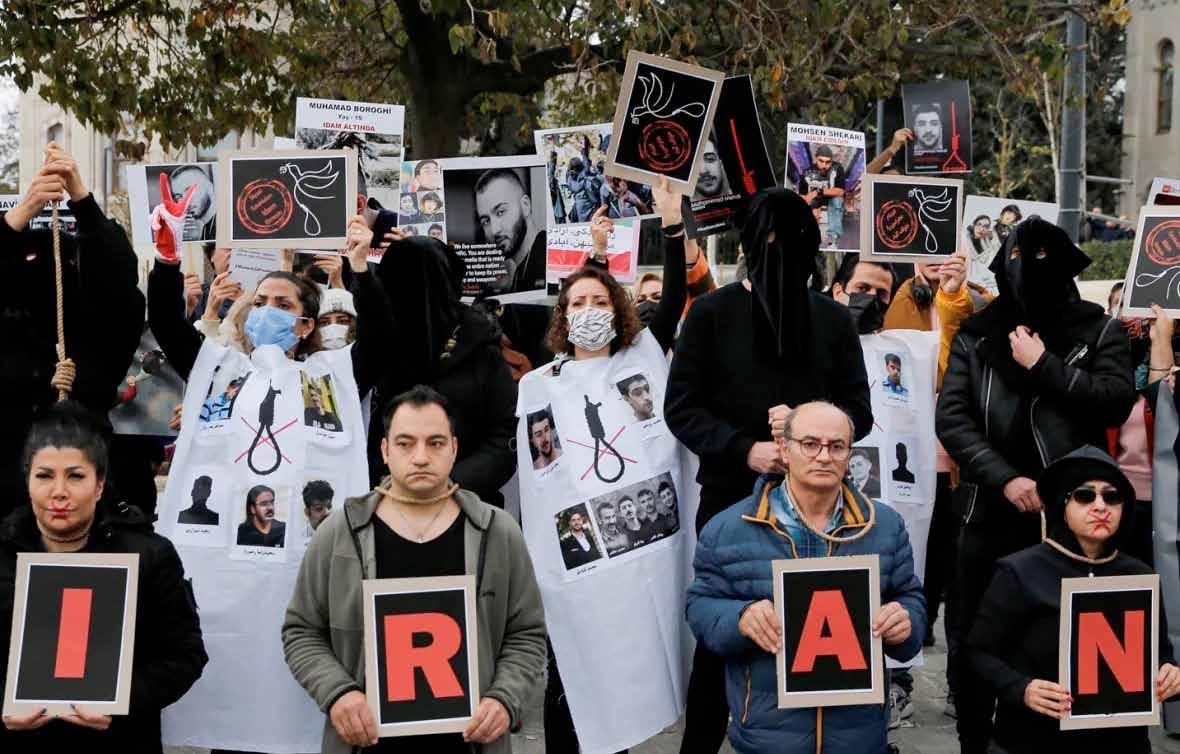
Another important factor to highlight in Rahnavard case is that this young protester had no previous criminal convictions.Iranian authorities said Rahnavard was executed as punishment for killing two Iranian security members during recent street riots. Here, people protest against the Islamic regime of Iran in Istanbul, Turkey, on Dec. 10. (Dilara Senkaya/Reuters)

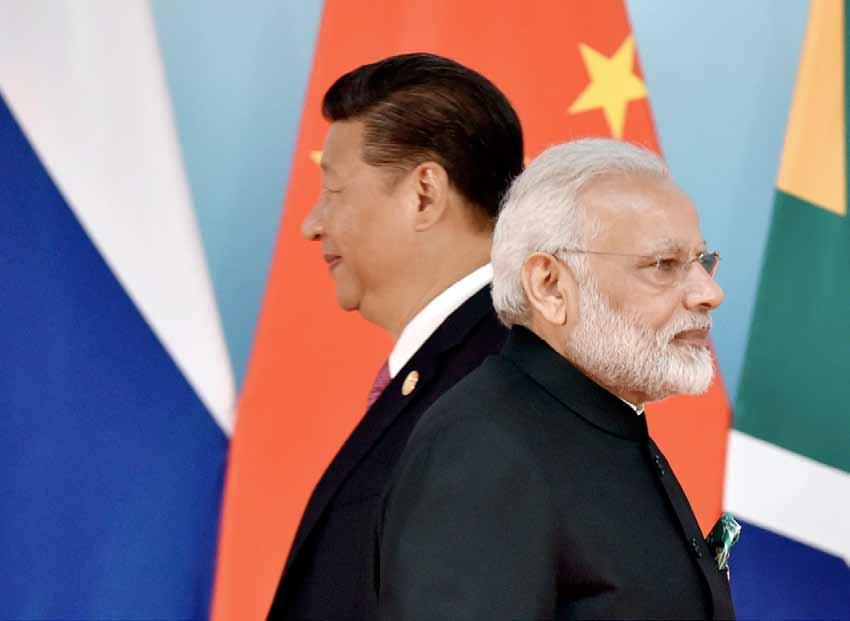
With China’s status as the “workshop of the world” marred by rising political risks, slowing growth, and increasingly untenable “zero COVID” policies, no country seems more poised to benefit than India. In May, The Economist ran a cover story about India, asking whether this was the country’s moment—and conclud-
ed that yes, it probably was. More recently, Stanford economist and Nobel laureate Michael Spence declared that “India is the outstanding performer now,” noting that the country “remains the most preferred investment destination.” And in November, Chetan Ahya, Morgan Stanley’s chief Asia economist, predicted that the Indian economy will account for one-fifth of global growth over the next decade.
Without a doubt, India could be on the cusp of a historic boom—if it manages to increase private investment, including by attracting large numbers of global firms from China. But will New Delhi be able to seize this opportunity? The answer is not obvious. Back in 2021, we provided a sobering assessment of India’s prospects in Foreign Affairs. We pointed out that popular assumptions about a booming economy were inaccurate. In fact, the country’s economic rise had faltered after the 2008 global financial crisis and stalled completely after 2018. And we argued that the reason for this slowdown lay deep in India’s economic framework: its emphasis on self-reliance and the defects in its policymaking process—“software bugs,” as we called them.
One year later, despite the exuberant press, India’s economic environment remains largely unchanged. As a result, we continue to believe that radical policy changes are needed before India can revive domestic investment, much less convince large numbers of global businesses to move their production there. An important lesson for policymakers is that there is no inevitability, no straight line of causation, from the decline of China to the rise of India.
In some ways, India looks like a promised land for global companies. It has structural advantages, its potential rivals have serious drawbacks, and the government is offering large investment incentives.
Start with the structural advantages. Commanding a territory that is nine times larger than Germany and a population that will soon overtake China’s as the world’s largest, India is one of the few countries that is big enough to house many large-scale industries, producing initially for global markets and ultimately for the burgeoning domestic market. Moreover, it is an established democracy with a long legal tradition and a notably young, talented, and English-speaking work force. And India also has some considerable achievements to its credit: its physical infrastructure has improved dramatically in recent years, while its digital infrastructure—particularly its financial payments system—has in some ways surpassed that of the United States.
Beyond these advantages, there is the matter of alternatives. If international firms do not go to India,

where else might they go? A few years ago, other South Asian countries might have been considered attractive candidates. But that has changed. Over the past year, Sri Lanka has experienced an epochal social, political, and economic crisis. Pakistan has been ravaged by an environmental shock that has aggravated its perennial macroeconomic vulnerability and political instability. Even Bangladesh, long a development darling, has been forced to borrow from the International Monetary Fund after Russia’s invasion of Ukraine caused commodity prices to soar, depleting the country’s foreign exchange reserves. Amid this South Asian “polycrisis,” as the economic historian Adam Tooze has called it, India stands out as a haven of stability.
More significant still is the comparison with China, India’s most obvious economic competitor. Over the past year, Chinese President Xi Jinping’s regime has been buffeted by multiple challenges, including slow economic growth and a looming demographic decline. The Chinese Communist Party’s draconian COVID-19 lockdowns and assault on the private sector have only made things worse. In recent weeks, Beijing has confronted an increasingly restive population, including the most widespread antigovernment protests the country has witnessed in decades. The country’s turn toward authoritarianism at home and aggression abroad—and the inept governance that has taken the sheen off the fabled “China model”—have made democratic India look even more inviting. Finally, India has taken steps that, on paper, should sweeten the deal for international firms. In early 2021, the government introduced its Production-Linked Incentives scheme to provide economic inducements to both foreign and domestic manufacturing firms who
India faces three major obstacles in its quest to become “the next China”: investment risks are too big, policy inwardness is too strong, and macroeconomic imbalances are too large.Chinese President Xi Jinping and Indian Prime Minister Narendra Modi attend a group photo session during the BRICS Summit in Xiamen, China, on Sept. 2017 ,4. KENZABURO FUKUHARA/AFP VIA GETTY IMAGES
“Make in India.” Since then, the PLI initiative— which offers significant subsidies to manufacturers in advanced sectors such as telecom, electronics, and medical devices—has had a few notable successes. In September 2022, for example, Apple announced that it plans to produce between five and ten percent of its new iPhone 14 models in India; and in November, Foxconn said it plans to build a $20 billion semiconductor plant in the country in conjunction with a domestic partner.
If India really is the promised land, however, these
examples should be joined by many others. International firms should be lining up to shift their production to the subcontinent, while domestic firms boost their investments to cash in on the boom. Yet there is little sign that either of these things is happening. By many measures, the economy is still struggling to regain its pre-pandemic footing.
Take India’s GDP. It is true—as enthusiastic commentators never cease to point out—that growth over the past two years has been exceptionally rapid, higher than any other major country. But this is largely a statistical illusion. Left out is that during the first year of the pandemic, India suffered the worst contraction in output of any large developing country. Measured relative to 2019, GDP today is just 7.6 percent larger, compared with 13.1 percent in China and 4.6 percent in the slow-growing United States. In effect, India’s annual growth rate over the past three years has been just two and a half percent, far short of the seven percent annual rate that the country considers to be its growth potential. The performance of the industrial sector has been weaker still.
And forward-looking indicators are hardly more encouraging. Announcements of new projects (as measured by the Center for the Monitoring of the Indian Economy) have again fallen off after a brief postpandemic rebound, remaining far below the levels
A telecast of Indian Finance Minister Nirmala Sitharaman at the Bombay Stock Exchange, Mumbai, India, February 2020. (Francis Mascarenhas / Reuters)
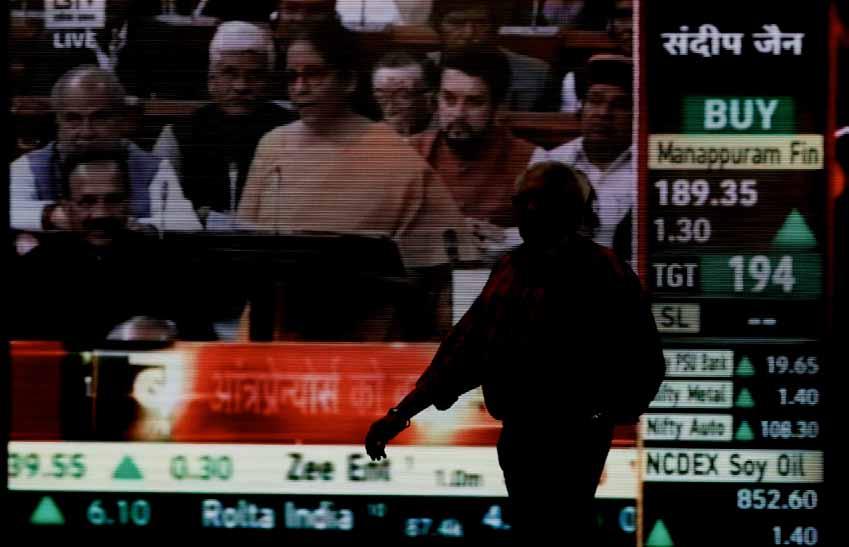
An important lesson for policymakers is that there is no inevitability, no straight line of causation, from the decline of China to the rise of India.
achieved during the boom in the early years of this century. Even more striking, there is not much evidence that foreign firms are relocating production to India. Despite all the talk about India as the investment destination of choice, overall foreign direct investment has stagnated for the past decade, remaining around two percent of GDP. For every firm that has embraced the India opportunity, many more have had unsuccessful experiences in India, including Google, Walmart, Vodafone, and General Motors. Even Amazon has struggled, announcing in late November that it was shutting three of its Indian ventures, in fields as diverse as food delivery, education, and wholesale e-commerce.
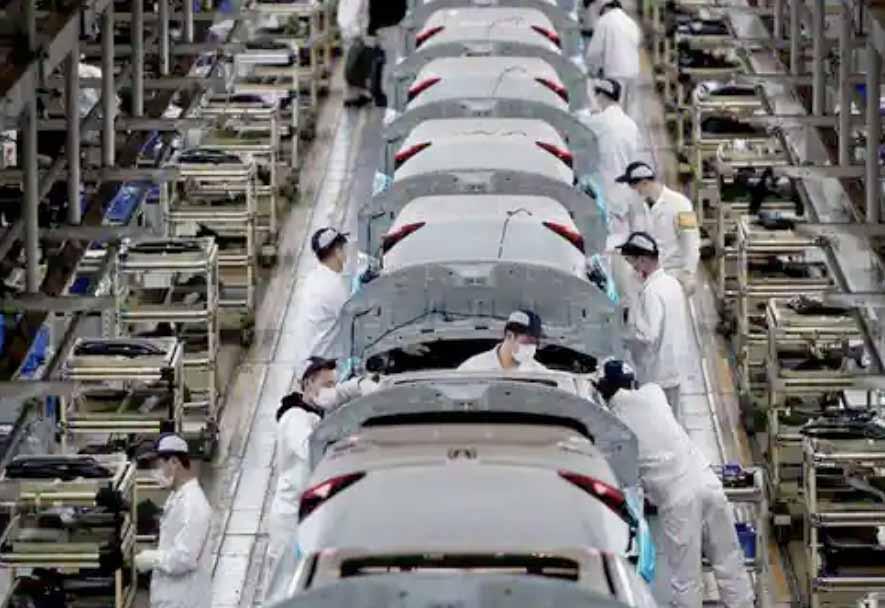
Why are global firms reluctant to shift their China operations to India? For the same reason that domestic firms are reluctant to invest: because the risks remain far too high.
Of the many risks to investing in India, two are particularly important. First, firms still lack the confidence that the policies in place when they invest will not be changed later, in ways that render their investments unprofitable. And even if the policy framework re-
mains attractive on paper, firms cannot be sure that rules will be enforced impartially rather than in favor of “national champions”—the giant Indian conglomerates that the government has favored.
These problems have already had serious consequences. Telecom firms have seen their profits devastated by shifting policies. Energy providers have had difficulty passing on cost increases to consumers and collecting promised revenues from the State Electricity Boards. E-commerce firms have discovered that government rulings about allowable practices can be reversed after they have made large investments according to the original rules.
At the same time, national champions have prospered mightily. As of August 2022, nearly 80 percent of the $160 billion year-to-date increase in India’s stock
The Chinese Communist Party’s draconian COVID- 19 lockdowns and assault on the private sector have only made things worse.
market capitalization was accounted for by just one conglomerate, the Adani Group, whose founder has suddenly become the third richest person in the world. In other words, the playing field is tilted. Nor can foreign firms reduce their risks by partnering with large domestic firms. Going into business with national champions is risky, as these groups are themselves seeking to dominate the same lucrative fields, such as e-commerce. And other domestic firms have no wish to tread in sectors dominated by groups that have received extensive regulatory favors from the government.

Apart from elevated risks, there are several other reasons why international firms are likely to remain gunshy about India. One of the key elements of the PLI scheme, for example, is raising tariffs on foreign-made components. The idea is to encourage firms relocating to India to purchase inputs in the domestic market, but the approach significantly hinders most global enterprises, since advanced products in many sectors are typically made of hundreds or even thousands of parts sourced from the most competitive producers worldwide. By attaching high tariffs to these parts, New Delhi has provided a powerful disincentive for firms contemplating investment in the country. For companies such as Apple that plan to sell their products in India, high import tariffs may be less of an issue. But these firms are few and far between, since India’s market of middle-class consumers remains surprisingly small—no more than $500 billion compared with a global market of some $30 trillion, ac-
cording to a study by Shoumitro Chatterjee and one of us (Subramanian). Only 15 percent of the population can be considered middle class according to international definitions, while the rich who account for a large share of GDP tend to save a large share of their earnings. Both factors reduce middle-class consumption. For most firms, the risks of doing business in India outweigh the potential rewards. Recognizing the growing tension between its protectionist policies and its goal of enhancing India’s global competitiveness, New Delhi has recently negotiated free trade agreements with Australia and the United Arab Emirates. But these initiatives—with economies that are smaller and less dynamic—pale beside those of India’s competitors in Asia. Vietnam, for example, has signed ten free trade agreements since 2010, including with China, the European Union, and the United Kingdom, as well as with its regional partners in the Association of Southeast Asian Nations (ASEAN).
In any country, a well-known prerequisite for economic takeoff is having key macroeconomic indicators in reasonable balance: fiscal and external trade deficits need to be low, as does inflation. But in India today, these indicators are off kilter. Since well before the pandemic began, inflation has been above the central bank’s legally mandated ceiling of six percent. Meanwhile, India’s current account deficit has doubled to about four percent of GDP in the third quarter of 2022, as it struggles to increase exports while its imports continue to grow.
Of course, many countries have macroeconomic problems, but India’s average of these three indicators is worse than in any other large economy, save the United States and Turkey. Most worrisome, India’s general government deficit, at around 10 percent of GDP, is one of the highest in the world, with interest payments alone accounting for more than 20 percent of the budget. (By comparison, debt payments account for just eight percent of the U.S. budget.) Aggravating the situation is the plight of India’s staterun electricity distribution companies, whose losses are now about 1.5 percent of GDP, over and above the fiscal deficits.
A final barrier to growth is a deep structural shift that
India’s current account deficit has doubled to about four percent of GDP in the third quarter of 2022, as it struggles to increase exports while its imports continue to grow.GETTY IMAGES
has undermined the dynamism and competitiveness of private enterprise. India’s very large informal sector has been especially hard hit: first by the 2016 demonetization of large-denomination notes, which dealt a devastating blow to smaller firms that kept their working capital in cash; then by a new goods-and-services tax the following year; and finally by the COVID-19 pandemic. As a result, employment of low-skilled workers has fallen significantly, and real rural wages have actually declined, forcing India’s poor and lowincome population to cut back their consumption.
These labor market vulnerabilities are a cautionary reminder that the country’s vaunted digital sector— whose promise does seem almost unbounded—employs high-skilled workers who constitute a small fraction of the workforce. As such, India’s rise as a digital powerhouse, no matter how successful, seems unlikely to generate sufficient economy-wide benefits to effect the broader structural transformation that the country needs.

In other words, India faces three major obstacles in its quest to become “the next China”: investment risks are too big, policy inwardness is too strong, and mac-
roeconomic imbalances are too large. These obstacles need to be removed before global firms will invest, since they do have other alternatives. They can bring their operations back to ASEAN, which served as the world’s factory floor before that role shifted to China. They can bring them back home to advanced countries, which played that role before ASEAN countries. Or they can maintain them in China, accepting the risks on the grounds that the Indian alternative is no better.
If the Indian authorities are willing to change course and remove the obstacles to investment and growth, the rosy pronouncements of pundits could indeed come true. If not, however, India will continue to muddle along, with parts of the economy doing well but the country as a whole failing to reach its potential.
Indian policymakers may be tempted into believing that the decline of China ordains the dizzy resurgence of India. But, in the end, whether or not India turns into the next China is not merely a question of global economic forces or geopolitics. It is something that will require a dramatic policy shift by New Delhi itself.
This article was originally published by Foreign Affairs.
Germany is facing largescale security challenges represented by the far-right groups and the extremist Islamist movements. Both further complicate the responsibilities of German security and intelligence services, given the repercussions of the Ukraine war, energy crisis, and the declining standards of living along with an economic slowdown. This has led to an increasing popularity of the far-right among Germans, and intelligence infiltrations into security and defense institutions, in parallel with the group’s intensive activities inside the Bundestag via the Alternative for Germany Party.
Germany’s far-right reorganized itself following the fall of Nazi Germany and the dissolution of the Nazi Party in 1945. The denazification of Germany was administered by the WWII Allies from 1945 to 1951. However, various far-right parties emerged after the war, achieving different degrees of success. Most of them were short-lived as they were banned or dissolved, and none of these parties were able to gain seats in the Bundestag at the time.
Founded in 1964, The National Democratic Party of Germany is the only remaining national political party that represents the Neo-Nazis in the country.
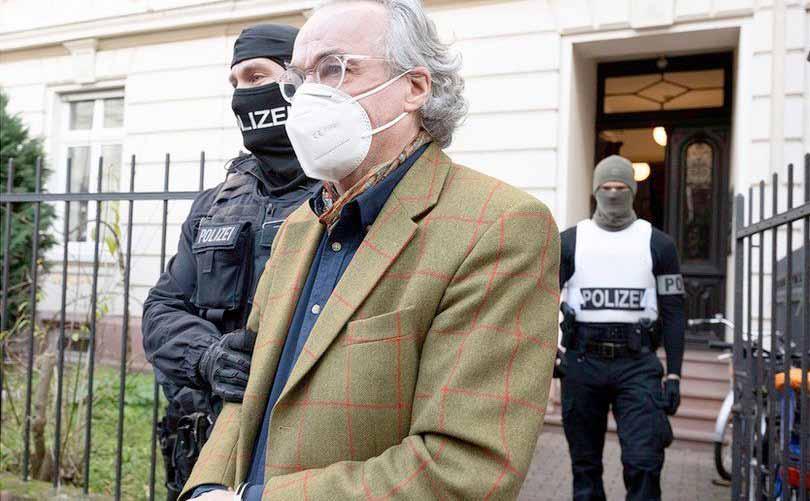
It won its first seats in the Saxony state elections in 2004, then in the Mecklenburg-Vorpommern state elections in 2006. It also won a seat in the European Parliament in 2014, but lost its remaining representation in the European elections in 2019.
The far-right extremism is characterized by its nationalist, anti-Semitic, racist and xenophobic ideology. Right wing extremists claim that the value of individuals is determined by their racial or national affiliation, which is a concept that totally conflicts with the country’s main laws. Remarkably, the new National Socialist ideology consists of two elements: nationalism and racism. Most far-right Germans either downplay or dignify the importance of the National Socialist movement. This recent concept definitely applies to the New National Socialists (Neo-Nazis) who consider the Third Reich a model for their political, economic and social objectives.
Anti-Semitism plays a central role for a majority of far-right groups. The International Holocaust Remembrance Alliance (IHRA) defines anti-Semitism as, “a certain perception of Jews, which may be expressed as hatred toward Jews. Rhetorical and physical manifestations of antisemitism are directed toward Jewish or nonJewish individuals and/or their property, toward Jewish community institutions and religious facilities.” IHRA further explains that various antiSemitic manifestations include charging Jews with conspiring to harm humanity or blaming the Jews collectively for the actions of Israel. Far-right extremists commonly believe in the authoritarian state which usually rejects the separation of powers that is applied in democracies. Neo-Nazis call for Führerstaat, the state of the leader, where all decisions and authorities are centered in his hands.
The far-right forms a radical and violent movement and the Reichsbürger does not recognize the democratic Germany. Its members believe that the current state is nothing more than an administrative structure that is occupied by Western powers – the United States, the United Kingdom and France – and that the 1937 borders of the German Empire still exist. They belong to the same organization of Reich Citizens

established in 1871.
The movement comprises smaller groups, which are mainly located in Brandenburg, Mecklenburg-Vorpommern, and Bavaria. Its members refuse to pay taxes and declare their own small “national territories” which they name “German Second Empire,” “Free State of Prussia,” or “Principality of Germania.”
Members of these groups print their own passports and driving licenses. They even produce their own shirts and flags for publicity. According to the estimates of the Federal Office for the Protection of the Constitution (BfV), there are 21,000 members of the Reichsbürger in Germany, 5% of whom are far-right extremists, mostly men. On average, they are above 50 years old, embrace populist, anti-Semitic, and Nazi rightist ideologies, and are scattered all over the country. One Reichsbürger group called the “United Patriots” was uncovered in April 2022, as its members plotted to kidnap the Federal Minister of Health Karl Lauterbach to force the Federal government to resign.
Many of the racist ideological principles adopted by the Nazis were transformed into the Nuremberg Laws that were issued by the German Reichstag on September 1935, marking a period of legal discrimination against those who were deemed of inferior race by the government.
The Reich Citizenship Law is one of the Nuremberg Laws which were unanimously approved by the Reichstag.
According to Article 1 of the Law: “A subject of the state is one who belongs to the protective union of the German Reich, and who, therefore, has specific obligations to the Reich. The status of subject is to be acquired in accordance with the provisions of the Reich and the state Citizenship Law.”
“Article 2: A citizen of the Reich may be only
The Reich Citizens can be the most dangerous among the racist and radical far-right groups.A minor aristocrat called Heinrich XIII was detained in the raids. DPA
one who is of German or kindred blood, and who, through his behavior, shows that he is both desirous and personally fit to serve loyally the German people and the Reich. The right to citizenship is obtained by the grant of Reich citizenship papers. Only the citizen of the Reich may enjoy full political rights in consonance with the provisions of the laws.”
German police and intelligence forces of more than 3,000 officers launched largescale raids against right wing extremism in 11 states, in
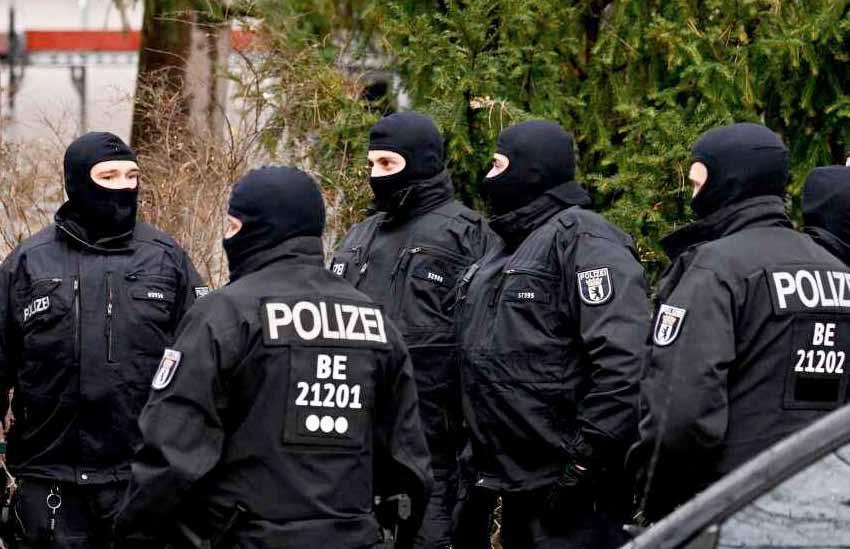
which 64-year-old Maximilian Eder was arrested in the Italian city of Perugia. According to the Guardian, “Along with 25 co-conspirators, Eder is accused of hatching a plan to overthrow the state by violent means, install a shadow government headed by a minor German aristocrat, and reach out to Russia to renegotiate post-second world war treaties.”
Although none of the conspirators is a wellknown public figure, their social background was surprising, as they included family doctors, judges, and an opera singer. In addition, the German ZDF reported that a civil servant at Lower Saxony’s criminal police office was also investigated for his connections to the group. Among those arrested were Birgit Malsack-Winkemann, a former Bundestag member of the Alternative for Germany Party, and a commander of one of the Bundeswehr’s armored infantry battalions between 1998 and 2000. She served in Kosovo and Afghanistan, was a co-founder of German Special Forces (KSK), and was named a commander of the group’s “military arm.”
A list of potential targets, retrieved from one suspect’s home during the raids, included seven members of Germany’s Bundestag, including the Green Foreign Minister Annalena Baerbock, and
Those right wing extremists have far-reaching connections, and commentators have warned against downplaying the arrested group and the risks they pose.
/ AP
Friedrich Merz, conservative opposition leader and the co-leader and general secretary of the Social Democratic party, the Guardian reported. According to the plot, Heinrich XIII, Prince Reuss, a minor aristocrat, was intended to be the new head of State.
Could such a coup succeed? Those right wing extremists have far-reaching connections, and commentators have warned against downplaying the arrested group and the risks they pose. Peter Neumann, an expert on radicalization, said that the Reichsbürger movement is capable of and willing to carry out terrorist attacks against the state.

What makes this specific group particularly dangerous is both its composition and ideology. Apparently, the arrested people belong to “a hodgepodge of extremists” that include the Reich Citizens and opponents of anti-Covid measures who took to the streets during the past two years. They share the same rejection of the democratic state.
They are mostly educated people who have pro-
fessions, remarked Andreas Zick, a sociopsychologist speaking to German media, adding that, “They are in parts educated groups, they are people who pursue a profession, who move from the center into the scene and can build a parallel society there. Over several years they were able to develop a cohesive milieu and forge and alliances to other groups.”
In addition to the judge and the Alternative for Germany former MP, those arrested included former army and police officers, and aristocrats. They are people with connections and perspectives on democratic institutions and financial resources. Many of them possess and can use firearms, which were confiscated during the raids. This makes the arrested people and their supporters a threat to the rule of law.
A German intelligence report covering the period from July 2018 to July 2021 expanded the definition of a far-right extremist to include members of “the Reich Citizens” who reject the modern German State, as the authorities were able to identify specific elements who adopt far-right ideology in addition to the racist and nationalist ideology.
According to the aforementioned 156-page report, 138 cases were confirmed by the federal
institutions, such as the federal army, police and major intelligence services. More 189 radical cases were uncovered by other state agencies. One mentioned example was a former army lieutenant called Franco A., who was brought to a Frankfurt court for plotting to assassin a politician. The authorities stated that Franco, who was arrested in 2017 while trying to load a gun he was hiding in an airport toilet and carrying a fake ID of a Syrian refugee, was motivated by a radical far-right ideology aiming to overthrow the country’s democratic regime.
There is a remarkable difference between nation-
al groups that advocate many slogans, such as “We are united Europeans,” and the whole spectrum of the far-right groups that totally reject the EU, NATO, and the US bases in Germany. The extremist right groups don’t have special programs as much as they are focused on capitalizing on government failures in economy, immigration, etc. They also share the same antiSemitic ideology.
They believe in “conspiracy theories” that suggest that some governmental policies aim at curbing freedoms and controlling the citizens. They are frequently labelled as “lateral thinkers,” due to their rejection of anti-Covid measures, the government aid and military assistance to Ukraine, and “being dragged” by NATO in this war.
The Reich Citizens can be the most dangerous among the racist and radical far-right groups, because:
First, their organization includes more than 20,000 members.
Second, they were able to obtain firearms and were trained to use them during service in security and defense institutions. More than one thousand members carry licensed firearms, and can afford buying weapons from the black market. Third, the movement members are close to decision-making circles, and can obtain classified information about raids and measures taken by the
A protester holds a sign reading «Freedom» at a protest against government measures to curb the spread of coronavirus disease (COVID19-) in Berlin, Germany August ,1 2021. Photo by Christian Mang/REUTERS
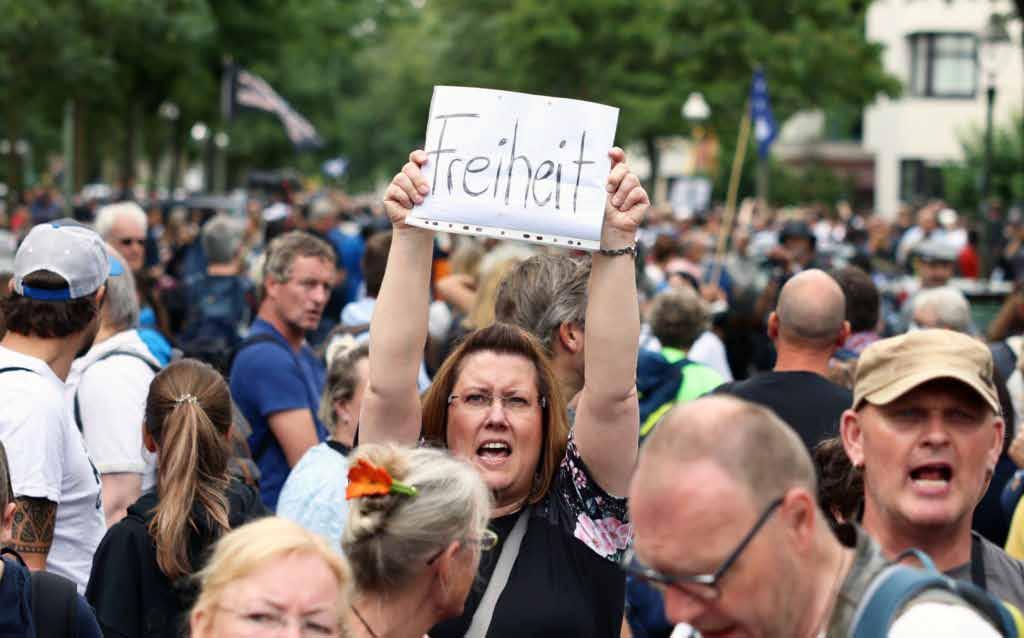
The movement members are close to decision-making circles, and can obtain classified information about raids and measures taken by the government against far-right.
government against far-right. A few years ago, the head of Germany’s domestic intelligence Maassen was forced out over far-right tendencies.
Fourth, the existence of Reichsbürger groups which have common extremist right wing racist ideology coincides with weak governmental policies to combat the far-right, due to financial and human inefficiencies. That has led to criticizing the German government for not taking strict deterrent measures against these groups. Describing the operation as a “coup” can be exaggerated. Germany is an EU and NATO member, with an army of 200,000, in addition to security and intelligence services. Thus, it is definitely able to “neutralize” this group and other farright groups. However, the threat of this movement should never be downplayed in combating radicalism and terrorism. We cannot dismiss the idea of the media using this incident to promote the government’s current approach and to gain popular support to pursue its energy policies and assistance to Ukraine.
German security and defense forces are wellequipped to disband some extremist groups. In the case of the Reich Citizens, it seemed that the authorities’ measures were late, but in in-

telligence terms they were preemptively able to dissolve the radical cells and prevent a terrorist operation. This indicates that the government has been monitoring the Reich Citizens for years, particularly after 2016, and was to detect the threat in November 2021, but still lacked accurate insider information.
German authorities have yet to intensify their efforts to include:
- Depending on intelligence more than military and police forces deployment;
- Monitoring and banning far-right social media activities as they are the groups’ most significant means of communications;
- Reviewing intelligence and defense operations to fill in the gaps and address any breaches;
- Tackling the far-right ideologies via educational curricula, and uncovering their threats in the Bundestag sessions, official federal websites and various media; and,
- Cooperating with other European countries and national law enforcement agencies in Germany in investigation, detection and data sharing.
It is expected that all forms of far-right threats remain in Germany, given the energy crisis, Ukraine war and immigration issues, in addition to the rise of far-right activities in the Bundestag despite the monitoring. Probably this is what led to a rise in far-right popularity in the present time.
With the Russian-Ukrainian conflict entering its tenth month, the lack of any hope for a diplomatic or military solution, and the arrival of all parties to a dead end, it has become clear that this war has become a game of finger-biting, not between Russia and Ukraine, but between Russia and NATO and the countries that revolve in its orbit.
The West, on the other hand, is certain that pushing Russia to the brink of nuclear war is tantamount to pressing the nuclear button, which has no mercy or consolation for the helpless world. So, we must re-read history for the sake of Ukraine and the world, learning from its lessons and absorbing its wisdom, because history does not lie.
Gamal Abd El-Maboud
While the Third World is suffering from the consequences of the UkrainianRussian war, the West did not attempt to compensate the weak countries whose economies are on the verge of collapse .
As for Ukraine as a state, it is a minor detail. No one cares about the scale of its destruction or the number of its refugees. Rather, the West must defeat Russian willpower now and forever in a war of depleting human, natural and political resources as shown by the departure of two British prime ministers, as well as the fall of Pakistan›s Imran Khan and so on. Moreover, there is lack of a political vision in dealing with the Ukrainian crisis, in conjunction with a Ukrainian president with no political experience who does not question Western intentions and motives encouraging him to wage war, and who has an unwavering belief in his ability to defeat Russia. He didn›t even pause to consider why the West forbids him from bombing targets inside Russian territory. Moreover, why, even before investigations began, was Biden so quick to deny Russia›s targeting of Polish lands? The reason is because the West seeks to drain Russia without engaging in military operations, the President of Ukraine serves as a Trojan horse which the West rides and controls.
When the Treaty of Versailles was signed after the German-led axis surrendered in World War I, and the peace conference was held in 1919 in the Palace of Versailles on the outskirts of Paris, it ended with a reasonable treaty for Germany›s surrender. However, the Allies decided that this was insufficient, so the treaty was amended in 1920 to force Germany to pay compensation for the Allies› losses in the war. As a result, Germany experienced depression and economic crises, which aided Hitler›s ascension to the throne and heralded the start of World War II.
Isn›t this reminiscent of the West›s statements about not allowing Russia to achieve a military victory and the threat to seize Russian funds in the West to fund Ukraine›s reconstruction? What›s the point? So, did the West follow the plan of Kissinger, the Fox of American Politics, following the October 1973 war and his declaration that the Arabs would not be allowed to use oil as a weapon again and would be forced to drink it if they did?
As a result, America rushed to stockpile oil in strategic warehouses, while Europe turned to Russia to rely on Russian oil and gas via pipelines to ensure its flow in all conditions. No one considered the possibility of a RussianUkrainian war, which would halt oil supplies and force the West to rely on Arab energy sources without blinking an eye at the failure of their plans and require the Russians to sell their oil to Europe for no more than a low price ceiling of sixty dollars.
Of course, the shipping companies, the majority of which are owned by Europe, will be compelled not to carry Russian oil if the price of a barrel exceeds sixty dollars, forcing the Third World to open its markets to their goods and using the International Monetary Fund as a cover for their economic greed while denying their colonial ambitions under the guise of free trade.
Despite the weak infrastructure of most Third World economies, it appears that Third World countries are doomed to apply market policies whenever the West wants, but this is only
political hypocrisy. While the Third World is suffering from the consequences of the Ukrainian-Russian war, the West did not attempt to compensate the weak countries whose economies are on the verge of collapse due to high fuel prices, the difficulty of obtaining adequate alternatives to Ukrainian grain, and the shrinking of Western aid due to economic crises no less severe than those experienced by the Third World. So the Europeans began to complain to their governments about their situation and the people are ready to revolt if they don›t get their afternoon tea with Black Forest cake.
As a result, we are facing a conflict between elephants which will break the glass, that is, the Third World and of course Ukraine. Unless America forces Ukraine to bear the burdens of war and begin a political process that begins with a mandatory review of history lessons, China will grow stronger, the multipolar world will return, Russia will further engage in the military conflict, and the Ukrainian people will spend a harsh winter without a clear goal.
Evacuees cross a destroyed bridge as they flee the city of Irpin, northwest of Kyiv, on March 7, 2022.
- Ukraine dismissed Moscow’s offer to set up humanitarian corridors from several bombarded cities on Monday after it emerged some routes would lead refugees into Russia or Belarus. The Russian proposal of safe passage from Kharkiv, Kyiv, Mariupol and Sumy had come after terrified Ukrainian civilians came under fire in previous ceasefire / AFP



In “Avatar: The Way of Water,” the director James Cameron pulls you down so deep, and sets you so gently adrift, that at times you don’t feel like you’re watching a movie so much as floating in one. From time to time he brings you to the bottom of an alien sea, shot with stunning hyperclarity in high-frame-rate 3D and teeming with all manner of surreally strange fish — all oddly shaped fins, decorative tentacles and other vestiges of an otherworldly, faintly screw-loose evolutionary timeline.

You can imagine the fun (and the headaches) that Cameron and his visual-effects wizards must have had designing this brilliant ocean-floor nirvana. You can also see an astronomical budget (reportedly north of $350 million) and an extraordinarily sophisticated digital toolkit at work, plus a flair for camera movement that, likely shaped by the director’s hours of deep-sea diving, achieves an exhilarating sense of buoyancy.
Much as you might long for Cameron to keep us down there — to give us, in effect, the most expensive and elabo-
Tuk (Trinity Bliss) in “Avatar: The Way of Water.” (Courtesy 20th Century Studios/TNS)
rate underwater hangout movie ever made — he can’t or won’t sustain all this dreamy Jacques-Cousteau-on-mushrooms wonderment for three-plus hours. He’s James Cameron, after all, and he has a stirringly old-fashioned story to tell, crap dialogue to dispense and, in time, a hell of an action movie to unleash, complete with fiery shipwrecks, deadly arrows and a whale-sized, tortoise-skinned creature known as a Tulkun.

All in all, it’s marvelous to have him back (Cameron, that is, though the Tulkun is also welcome). He remains one of the few Hollywood visionaries who actually merits that much-abused term and who has more on his mind than just pummeling the audience into submission. As such, he wants to submerge you in another time and place, to seduce you into a state of pure, unforced astonishment. And he does, after some visual adjustment; the use of high frame rate (a sped-up 48 frames per second) tends to work better underwater than on dry land, where the overly frictionless, motion-smoothed look might put you briefly in mind of a Na’vi soap opera (“The Blue and the Beautiful,” surely). But then he can captivate you with something as lyrically simple — but actually, as painstakingly computer-generated — as a shot of his characters sitting beside the water at night, their faces and bodies reflecting the digital phosphorescence below. Any hack can make stuff blow up real good; Cameron makes stuff glow up real good.
In this long-running, long-gestating sequel to his 2009 juggernaut, “Avatar,” Cameron returns you to that distant moon called Pandora, though most of the action unfolds far from the first movie’s majestic floating mountains and verdant rainforests. We encountered that dazzling, soonto-be-despoiled Eden through the eyes of Jake Sully (Sam Worthington), a square-jawed, soft-hearted ex-Marine sent by his ruthless corporate overlords to infiltrate the Na’vi, a powerful race of blue-skinned, yellow-eyed, cat-tailed humanoids who lived in astonishing oneness with all living things. Transplanted into his own genetically tailored Na’vi body, or avatar, Jake didn’t take long to switch allegiances and turn against humanity, having fallen hopelessly in love with Pandora’s beauty and also with a Na’vi warrior princess, Neytiri (Zoe Saldaña).
“Avatar” was a thrilling moviegoing experience and a pioneering showpiece for performance-capture technology, which allowed Cameron and his actors to endow their Na’vi characters with astonishingly detailed and lifelike gazes, gestures and physiognomies. The movie was also built on a consciously thin story, with thudding echoes of anti-imperialist westerns like “Dances With Wolves” and the fondly remembered eco-conscious animation “FernGully: The Last Rainforest.” But then, Cameron’s cuttingedge technophilia has always been married to, and com-
plemented by, an unapologetic cornball classicism. And if it was easy to snicker at “Avatar’s” hippy-dippy sincerity, it was also easy to surrender to its multiplex transcendentalism, its world of synthetically crafted natural wonders. Here was the rare studio picture that seemed enlivened, rather than undermined, by its contradictions.
If anything, those contradictions hit you with even greater force in “Avatar: The Way of Water,” which fully and subtly immerses you in the Na’vi world from start to finish. The level of computer-generated artifice on display in every landscape and seascape is cumulatively staggering, in ways to which even the first movie, toggling insistently between Jake’s human and Na’vi experiences, didn’t aspire. Just as crucially, the stakes have risen, the emotions have deepened and the brand-extension imperatives that typically govern sequels are happily nowhere in evidence.
That might seem remarkable, considering that the “Avatar” series (at least three more movies are planned), like all properties of the former Fox Studios, now belongs to Disney, speaking of ruthless corporate overlords. But then, it’s no surprise that the director of “Aliens” and “Terminator 2: Judgment Day,” two of the most indelible sequels in action-cinema history, knows a thing or two about intelligent, expansive franchise building. And as “The Abyss” and “Titanic” bore out, Cameron also knows a thing or two about water, which is where this latest sequel finds its sweet spot: Welcome to Pandora’s beach.
But first, there’s a truckload of exposition to get through. As in the first movie, Jake obliges with the kind of grunting film-noir-gumshoe voiceover that reminds you, in ways more endearing than irritating, that snappy exposition will never be one of Cameron’s strong suits. (He co-wrote the script with Rick Jaffa and Amanda Silver.) Several years after shedding his own avatar and being reborn as a fullblown Na’vi, Jake has mastered his post-human way of life. He and Neytiri are parents to four Na’vi children: two
“Avatar,” Cameron returns you to that distant moon called Pandora, though most of the action unfolds far from the first movie’s majestic floating mountains and verdant rainforests.
teenage sons, Neteyam (Jamie Flatters) and Lo’ak (Britain Dalton); an 8-year-old daughter, Tuk (Trinity Bliss), and an adopted teenage daughter of mysterious provenance named Kiri. She’s played by Sigourney Weaver, a casting choice that naturally ties her to Dr. Grace Augustine, Weaver’s deceased scientist from the first movie, initiating a mystery that will presumably be unraveled further down the franchise road.
Weaver’s casting also raises some odd, potentially discourse-sowing questions about Kiri’s chaste (for now) bond with a young human male and fellow foundling named Spider (Jack Champion), who likes to run, bare of chest and foot, with the Sully clan. But if their friendship makes for an optimistic portrait of interspecies harmony, Cameron doesn’t linger on it for long. Instead, he unleashes a grave threat that drives Jake and Neytiri from their Omaticayan jungle home and sends them fleeing to the ocean, where they seek refuge with a civilization of Na’vi reef dwellers known as the Metkayina.
It’s a shrewd narrative gambit that not only refreshes the scenery (and how!) but also forces Jake, Neytiri and their family to adapt to an entirely new way of life, cueing a second-act training regimen that allows Cameron to show off every square inch of his aquatic paradise. (His key collaborators include his longtime cinematographer, Russell Carpenter, and production designers Dylan Cole and Ben Procter.)
Led by the kind, welcoming Tonowari (Cliff Curtis) and his less hospitable wife, Ronal (a glaring Kate Winslet), the Metkayina are a highly evolved clan of water dwellers, as underscored by their aquamarine skin (in contrast to the Omaticayans’ cerulean tones), seashell-and-fishnet jewelry and intricate tattoos, reminiscent of Maori body art. They
also boast unusually thick, long tails built for underwater propulsion. For Jake, Neytiri and especially their children, learning to navigate the watery wilderness just outside their new beach-bum paradise will prove a difficult challenge. It’ll also earn them some mockery from the locals, especially Tonowari and Ronal’s own teenage children, in a story that sometimes plays like a teen surfing movie by way of “Swiss Family Robinson.”
Even coming from a filmmaker used to setting intimate relational sagas against large-scale tragedy, the tenderness and occasional sentimentality with which Cameron invests this drama of family conflict and survival feels unusually personal. It can also feel a bit thinly stretched at three hours, but even that seems more an act of generosity than indulgence on Cameron’s part; his attachment to this family is real and in time, so is yours. Audiences expecting propulsive non-stop action, rather than the director’s customary slow build, may be surprised to find themselves watching a leisurely saga of overprotective parents and rebellious teens, biracial/adoptive identity issues and casual xenophobia. They’ll also be treated to some lovely whalespeak courtesy of those mammoth Tulkuns, who turn out to be engaging conversationalists as well as formidable fighters.
If you’re impatient, sit tight: The action is still to come, much of it dispensed by a snarling reincarnation of the first movie’s ex-military villain, Col. Miles Quaritch, here reborn — and played once more by the ferocious Stephen Lang — as a Na’vi avatar implanted with a surviving packet of the colonel’s memories. Bigger, badder and bluer than before, Quaritch 2.0 isn’t looking for unobtainium, the first movie’s stupidly, wonderfully named mineral MacGuffin. All he really wants is
From left, Neytiri (Zoe Saldana) and Jake Sully (Sam Worthington) in “Avatar: The Way of Water.” (Courtesy 20th Century Studios/TNS)

revenge
As “The Abyss” and “Titanic” bore out, Cameron also knows a thing or two about water, which is where this latest sequel finds its sweet spot: Welcome to Pandora’s beach.
against Jake and his family. (It’s personal for him, too.) His Na’vi transformation leaves only a handful of human characters, some of them old friends (Joel David Moore, Dileep Rao), though most of them are puny, inconsequential villains who rain down destruction on the Metkayina and their delicate ecosystem, only to reap destruction in return. Like its predecessor, “Avatar: The Way of Water” is both an environmental cautionary tale and a madly effective opportunity to root against our own kind; by the time the third act kicks in, you’ll be screaming for human blood.
Cameron’s return trip to Pandora has been long in the making and nearly as long in the mocking. Over 13 years of ever-shifting industry buzz about possible sequels, sequels to sequels and countless changes of plan, more than a few have expressed exasperation with the director’s ever-outsized ambitions and even cast doubt on the first “Avatar’s” pop-cultural legacy. It’s hardly the first time Cameron has been dinged in advance for an Olympian folly, and if the pattern holds, this latest and most ambitious picture will stun most of his naysayers into silence. “Never underestimate James Cameron” has become something of a mantra of late when, in fact, the underestimation is crucial. It’s part of the director’s hook, his wind-up showmanship, his belief that moviegoing can be a religious and even redemptive experience. The more he suffers, the more he can thrill us, and the more fully the wonder of cinema can be reborn.
You don’t have to buy into that self-mythologizing to surrender, even if only intermittently, to the lovely, uneven, transporting sprawl of “Avatar: The Way of Water.” Certainly it’s hard not to feel moved and even heartened by
the conviction of Cameron’s filmmaking, the unfeigned sincerity with which he directs a young Metkayina woman to solemnly intone, “The way of water has no beginning and no end.” That could be interpreted as a dig at the running time, but it also nicely articulates Cameron’s sense of visual continuity. As with the first “Avatar,” the immersive fluidity he achieves here feels like an organic outgrowth from his premise, a reminder that all life flows harmoniously together.
Where it will flow next is a mystery, and it’d be disingenuous of me to suggest I’m not eager to find out. Until then, Pandora, so long, and thanks for all the fish.
‘AVATAR: THE WAY OF WATER’
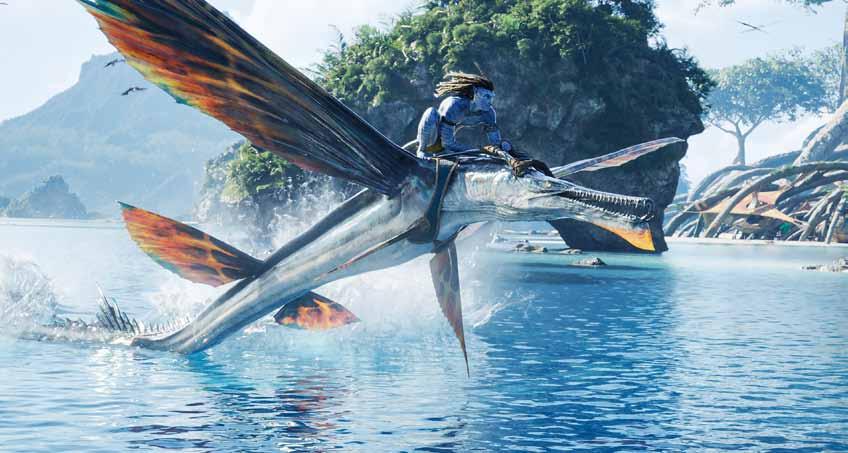
(In English and Na’vi dialogue with English subtitles)
Rating: PG-13 (for sequences of strong violence and intense action, partial nudity and some strong language) Running time: 3:10 How to watch: In theaters Friday
This article was originally published by Los Angeles Times.
The tenderness and occasional sentimentality with which Cameron invests this drama of family conflict and survival feels unusually personal.Jake Sully (Sam Worthington) in “Avatar: The Way of Water.”
Football or soccer? As newcomers to the popular worldwide and centuries-old sport, the Americans have shown little interest in the current competitions for FIFA’s World Cup in Qatar –not even calling it “football,” while showing no small amount of condescension.
On the day of the opening of the competition, many major American newspaper headlines used the word “culture” to imply differences with faraway Arabs and Muslims who, for the first time, hosted such an international sports gathering. The US lack of interest starts with the name of the sport.
According to the American Heritage Dictionary, in “football” an “oval” ball is used in “running or passing … or kicking it through the air,” while in “soccer” a “round” ball is used in “kicking, heading, or using any part of the body except the arms and hands.”
While “soccer” is mostly American (although with British roots), “football” is worldwide in different languages. The name of the game in Europe, for example, is German “futsball,” Spanish “futbol” and Danish “fodbold,” and in other languages is “koorata al qadam” in Arabic, “zuqiu” in Chinese, and “soka” in Swahili. On the opening day of the games in Qatar, head-
lines of major American newspapers were a bit condescending:
The Washington Post: “With charm and conflict, World Cup arrives in Qatar; Cultures clash as an Arab nation hosts soccer’s showcase event for the first time.”
The Los Angeles Times: “A culture clash on and off the pitches; In Word Cup gamble; Qatar walks tightrope between Arab values and Western norms.”
A few other American newspapers published, on their front or inside pages, parts of an Associated Press long piece that was titled: “Culture clash? Conservative Qatar preps for the World Cup party.”
Three issues dominated American coverage of the tournament, and were mostly targeting Qatar, the host:
First, violations of human rights, like its treatment of guest workers, particularly those who built the huge stadiums and other event’s facilities.
Second, the last-minute prohibition of drinking alcohol and beer in stadiums, but they were available in certain hotels.
Third, decades-long animosity to gays and lesbians, and the pressure that was put on FIFA to
threaten to punish pro-LGBTQ armband players.
There was more negative coverage in other American media, such as the magazine covers of Time: “Thousands of Migrant Workers Died in Qatar’s Extreme Heat. The World Cup Forced a Reckoning,” and the Week: “A divisive World Cup: Has Qatar scored an own goal?”
Newsweek has been publishing pieces with headlines such as: “Voters Deplore the World Cup Being Held in Qatar”, “Soccer ‘Forever Stained’ by Qatar World Cup”, “Should the U.S. Boycott the World Cup?” and describing FIFA “as a Cartel-Like Group of Scumbags.” This is not to say that the Americans were any less enthusiastic in supporting their team as those of other nations. Obviously not crazy about Cristiano Ronaldo of Portugal and Lionel Messi of Argentina and other goal-scoring wizards celebrated around the world, the Americans had Tyler Adams, the first Black American captain of the American team for an entire World Cup –and, at 23-years-old, the youngest.
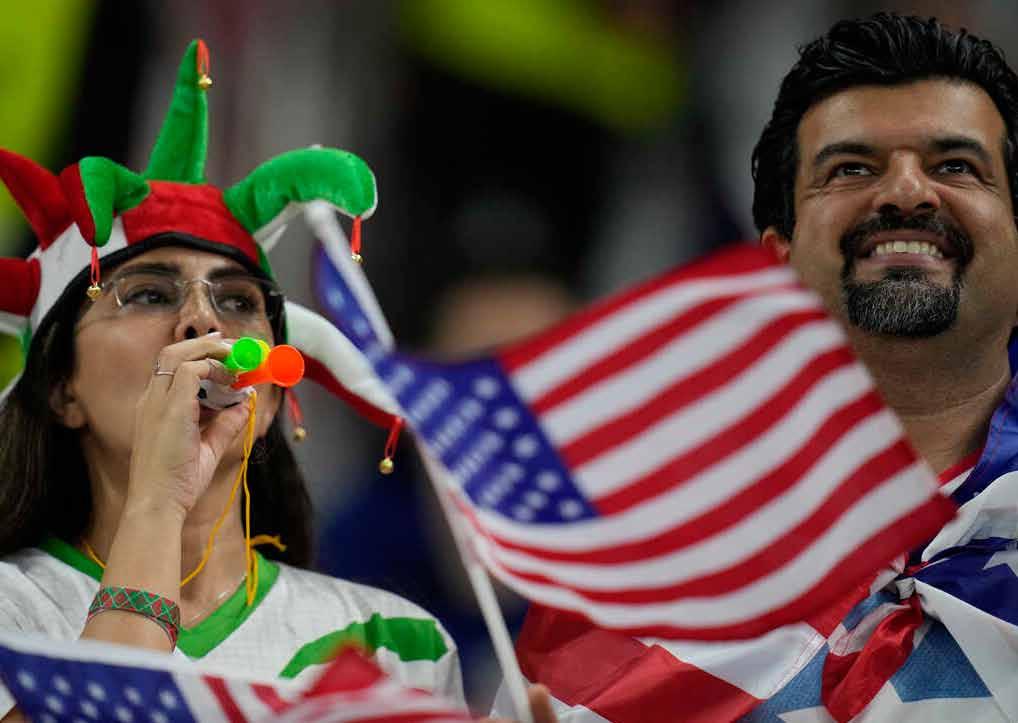
Although he is playing for British Leeds United, and before that he played for the German Leipzig team, he represented the U.S. in international competitions even before Qatar’s World Cup competitions.
With the Americans recently engaged during the last few years in intense discussion about race, particularly about Blacks facing racial discrimination and the US reckoning of its history of slavery, having a Black team leader was sig-
During a news conference, an Iranian journalist criticized Adams for mispronouncing “Iran,” and asked him how he felt about representing a country that “has so much discrimination against Black people.”
nificant. Adams was born to an-unmarried White mother and a Black father that he didn’t know, and later he became part of his mother’s White family, identifying himself as Black. When the American team returned from Qatar, Adams was celebrated as a symbol of America’s racial reconciliation.
Adams was also celebrated for facing up to a negative question about race in America by an Iranian journalist in Qatar. However, from
the beginning, the American game with Iran was loaded with negative coverage in view of the decades-old bad relations between the two countries – and the Iranians were not less political.
During a news conference, an Iranian journalist criticized Adams for mispronouncing “Iran,” and asked him how he felt about representing a country that “has so much discrimination against Black people.”
Adams, replying to the Iranian journalist, made a memorable statement: “There is discrimination everywhere you go.”
At one point, the Iranian team demanded that the American team be kicked out of the tournament after the American Soccer Federation altered the Iranian flag in its website, expunging the word “Allah.” Adams didn’t know, was surprised, apologized, and the Federation deleted the altered flag.

Finally, the Americans, like other teams that didn’t make it to the top, were optimistic about the future. In the words of Time magazine, “Despite World Cup Heartbreak, the Future Looks Bright …” Especially because most of the 2026 competitions will be held in the U.S.”
Iranian
29, 2022. (AP)
On the day of the opening of the
many major
headlines used
“culture” to imply differences with faraway Arabs and Muslims who, for the first time, hosted such an international sports gathering.and US supporters cheer before the World Cup group B soccer match between Iran and the United States at the Al Thumama Stadium in Doha, Qatar, Tuesday, Nov.


Despite losing 2-0 to Didier Deschamps’ side to end a historic run at the tournament, with becoming the first African team to reach the World Cup’s final four, Morocco are the underdogs who were ‘the Rocky of this World Cup’.
Morocco has defeated Belgium (world number 2), Spain (7), and, most recently, Portugal (9) without conceding a goal. They also held Croatia to a goalless draw in their Group stage, the 2018 finalists also reaching the semi-finals this time around. In fact, their only goal this tournament was an own goal in a 2-1 win over Canada.
It is nothing less than miraculous. Walid Regragui, the team’s coach, was appointed only on August 31 - and when he was appointed, the shaved-head mastermind was mockingly dubbed “avocado head” by pundits in the northern African nation.
On Morocco’s miraculous run, Regragui has proven all the doubters wrong, and FIFA even photoshopped an avocado next to his head, with a miniature football inside, in a playful dig at his detractors. Many Moroccans questioned the Moroccan Football Association (FRMF)’s decision to appoint Regragui
as head coach of the Atlas Lions because of the appointment’s “critical” timing, as well as Regragui’s lack of experience, despite the fact that he previously performed well with the Wydad Athletic Club. After becoming the first African team to reach the World Cup semi-finals, Walid Regragui urged Mo-
Morocco manager Walid Regragui is given the bumps by his players after the World Cup Round of 16 victory against Spain at the Education City Stadium in Al Rayyan, Qatar, on Tuesday, December ,6 2022. (AP)
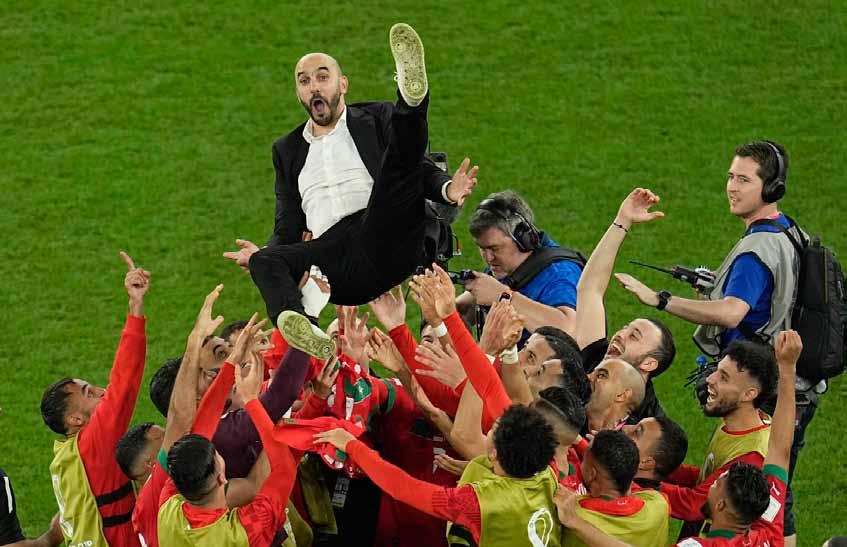
rocco to keep dreaming of making even more history. Despite the fact that Regragui was regarded as a nameless and inexperienced coach, one of Regragui’s most notable accomplishments has been reintegrating Chelsea’s Hakim Ziyech and Bayern Munich’s Noussair Mazraoui back into the squad after international exiles for both players, both of whom are now crucial to Morocco.
“What’s important for future generations is that we’ve shown that it is possible for an African team to get to the World Cup semi-finals. Why not make it the final?” coach Regragui said immediately after Portugal’s victory.
“I was asked three or four games ago if we could win the World Cup. ‘Why not?’ I reasoned. We can fantasize. Why shouldn’t we fantasize? You won’t get anywhere if you don’t dream. It is completely free of charge.”
“European countries are used to winning the World Cup, so we’ll have to try to get in there - and go above and beyond.”
Rocky Balboa was able to receive three Oscars, a Golden Globe, several other awards, and the admiration of the entire world over the years. And Walid Regragui chose that short but big-hearted amateur boxer who came out of the Philadelphia suburbs and became a world champion to compare and explain his
amazing Morocco.
Regragui, born in France, was a former defensive player who played for clubs such as Toulouse, AC Ajaccio, Grenoble, and Racing Santander in the French league. For his final season as a player, he moved from Grenoble to the Moroccan club Moghreb Tétouan in the summer of 2009.
In September 2012, he worked as an assistant coach with the Moroccan national team and briefly with the Qatari sports club Al Duhail after retiring. The following year, he was appointed head coach of Moroccan football club Fath Union Sport for the 2014-15 season.
Growing up, Regragui’s first connection to his Moroccan heritage was school vacations spent visiting
They’re the underdogs who are sweeping the World Cup. Morocco has advanced to the semi-finals of the World Cup in Qatar, becoming the first African, Arab, and Muslim country to do so.
relatives in Morocco.
Moreover, just like Regragui, many of his teammates were born abroad: 14 of their 26 players, the most of any nation.
Morocco launched a concerted effort in 2014 to persuade foreign-born talent to represent the country of their ancestors rather than the country of their birth.
Early the following year, Ziyech was on the verge of joining the Netherlands national team, but he chose to leave their training camp and abandon the country. He made his Morocco debut later that year and has played an important role in Morocco’s rapid rise, scoring against Canada and then converting a penalty in a shootout win over Spain. Regragui had been named head coach of Moroccan
sports club Wydad AC’s Botola team by mid-2021. Walid Regragui, dubbed “The Moroccan Guardiola,” led Wydad to one of their best seasons in club history. It would be unfair to view the young coach’s CAF Champions League victory as the be-all and end-all of his football achievements, not least because he has already worked on two continents.
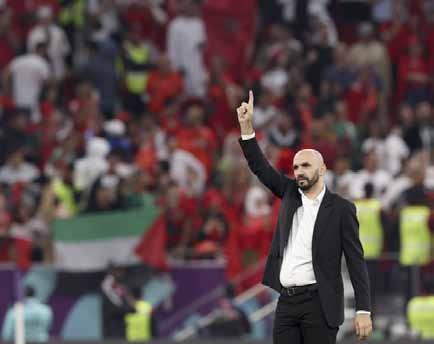
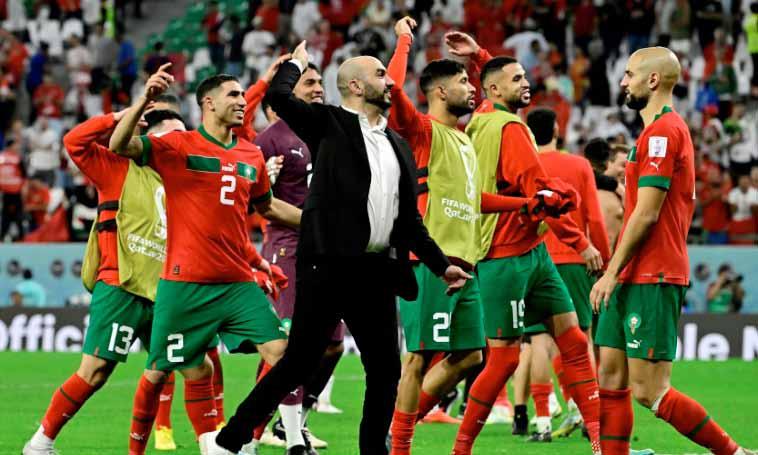
Walid Regragui, 46, signed a contract with Morocco’s football federation in August 2022, which runs through the 2026 World Cup. Former coach Vahid Halilhodzic was fired due to “differences and divergent visions” with the federation.
(Xinhua/Cao
Regragui, a relative newcomer to coaching, has coached 200 games in his career, including a stint at Qatari team Al-Duhail in addition to stints at Fath and Wydad.
Regragui is the second Moroccan to lead the Atlas Lions in the world’s biggest tournament. The first was Abdellah Blinda at USA 1994, the country’s third World Cup.
Walid Regragui and his charges arrived in Qatar as underdogs in a Group that included Belgium, Croatia, and Canada, as well as star-studded Belgium.
A 0-0 draw with Croatia was followed by a surprise 2-0 win over Belgium before the Atlas Lions finished Group leaders with a 2-1 win over Canada. The match against Spain in the Round of 16 was up next.
Over 120 minutes, a compact and disciplined defensive performance against Luis Enrique’s Spain was capped by a 3-0 penalty shootout victory to advance to the Quarter Finals.
After that, the North Africans defeated Portugal 1-0 in the quarter-finals to become the first African country to reach the final four in the tournament’s history. Regragui is also the first African coach to lead an African team to the World Cup semi-finals.
Global football body FIFA described Regragui as “Morocco’s hero at Qatar 2022” and applauded Lekjaa’s decision to appoint him.
“The spirit Morocco has shown in Qatar, the renewed bonds within the team and the significant impact of returnees Ziyech and Mazraoui have all proven Lek-
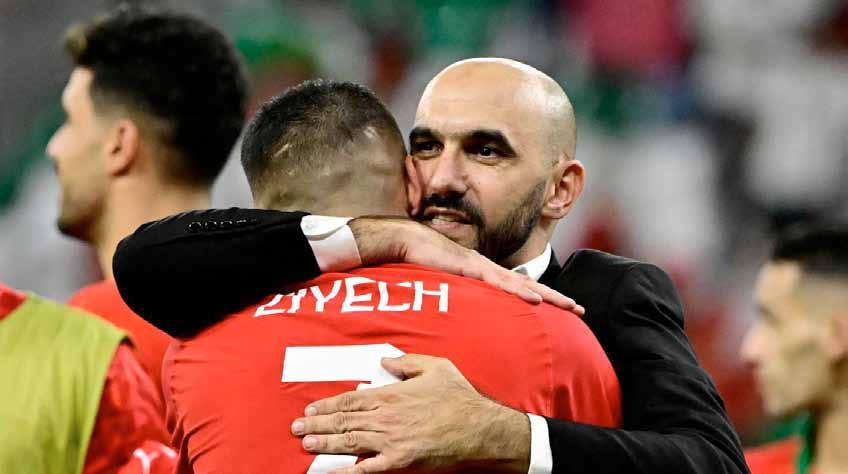
jaa’s decision to be absolutely correct. It is also evidence that a united dressing room can be as important as tactics or coaching,” FIFA said in a statement.
FIFA emphasized Moroccan player development and improved performance over the years, while crediting Moroccan fans for playing “a hugely important role in their national team’s success” by turning out in their thousands to support them in Qatar.
French coach Didier Deschamps, who won the World Cup four years ago and had to get past Morocco to return to the final, said his opponents’ success is no fluke.
“Morocco deserves everyone’s recognition,” he said. “When you face the teams they have met, had their results and conceded only one goal in five games, you can no longer say that it’s a surprise. They have earned their place.”
Regragui has embraced his team’s longshot status by comparing it to the ultimate underdog.
After becoming the first African team to reach the World Cup semi-finals, Walid Regragui urged Morocco to keep dreaming of making even more history.
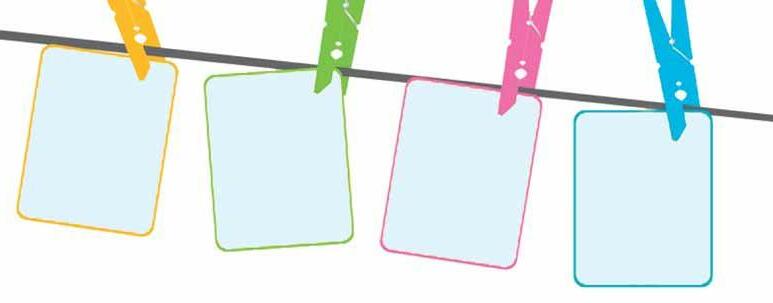
The German Chancellor, Olaf Scholz, surprised observers by appointing Nancy Faeser, the leader of his party team in the Hesse State Parliament, to succeed Horst Seehofer as the first woman to hold this position in Germany.
Faeser was a member of her party’s delegation in the working group on migration and integration, co-chaired by Boris Pistorius, Luise Amtsberg, and Joachim Stamp, during negotiations to form a so-called “traffic light coalition” of the SPD, the Green Party, and the Free Democrats (FDP) following the 2021 German elections.
After the coalition was formed successfully, it was announced on December 6, 2021, that Faeser would become the first female Interior Minister of Germany in the Scholz cabinet.
Faeser attends meetings of the Standing Conference of Interior Ministers and Senators of the States in her capacity as minister (IMK).
Faeser was nominated by her party to serve as a delegate to the Federal Convention in order to elect the President of Germany in 2022.
Faeser, 52, has spent her entire life in politics, as her father was the leader of the Social Democratic Party in Schwalbach am Taunus, near Frankfurt.
She joined the party when she was eighteen and rose through the ranks to become the head of her party’s state branch three years ago. In 2019, she succeeded Thorsten Schäfer-Gümbel as the party’s leader in Hesse.
Although Faeser had never held a ministry in the Hesse government, the leaders of her party chose her as Minister of the Interior because of her long experience with the thorny topics that occupy the Ministry of the Interior, including the far-right issue.
Faeser attended elementary school in Schwalbach am Taunus, a Frankfurt am Main suburb, and graduated from the AlbertEinstein-Gymnasium with a high school diploma (German: Abitur).
Faeser studied law at Frankfurt’s Johann Wolfgang Goethe University from 1990 to 2000. She finished a semester abroad at New College of California and passed her second state bar exam to become a licensed attorney.
Faeser worked as a research assistant at Clifford Chance in Frankfurt am Main until 2000, and then as a full-time lawyer at Clifford Chance from 2000 to 2007. Since taking over internal policy matters in her party in 2009, Faeser has worked on the far-right issue and chaired the investigation committee of her party to handle the NUS file, which is considered one of the largest judicial files in Germany. She was able to identify serious imbalances in the work of the Internal Intelligence Service as a result
of this.
Faeser extended border checks at Austrian crossings for six months during her first year in office in response to an increase in the number of migrants arriving via the Western Balkans route.
Faeser’s Ministry of the Interior closed the “Expert Group on Political Islamism” established by her predecessor, Horst Seehofer, in September 2022.
She expressed concern about the increased number of migrants entering Europe via the Balkan route in October 2022.
Prior to the 2022 FIFA World Cup in Qatar, she stated in an interview with ARD’s Monitor that awarding major sporting events should be linked to compliance with human rights and sustainability principles, saying: “There are criteria that must be adhered to, and it would be better that tournaments are not awarded to such states.” The Gulf Cooperation Council condemned the remarks, and the Qatari Ministry of Foreign Affairs summoned the German ambassador and handed him a letter of protest in response to her statements.
On November 23, Faeser attended Germany’s first World Cup game, wearing a OneLove armband (a pro LGBTQ+ symbol), which FIFA had prohibited players from wearing in the tournament with threats of sanctions.
In terms of her private life, Faeser has been married to her husband, lawyer Eyke Grüning, since 2012. The couple lives in Schwalbach am Taunus with their son.
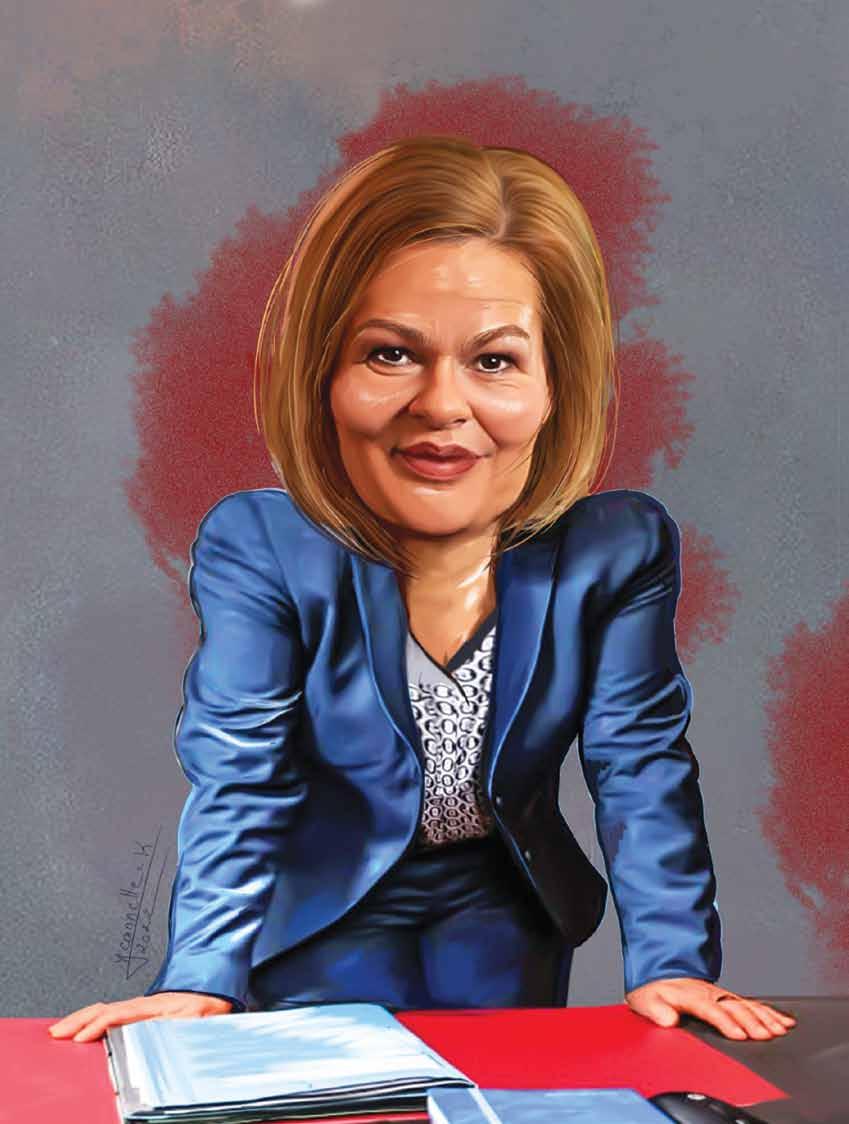
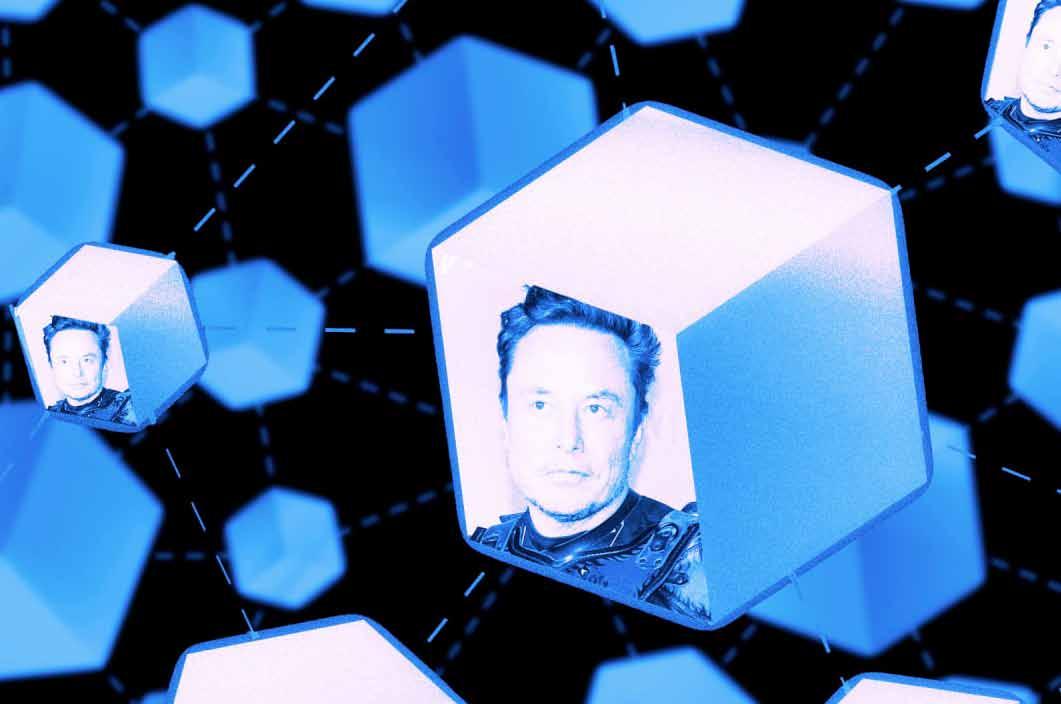 By Woody Lewis
By Woody Lewis
The story of Elon Musk’s on-again, off-again, on-again deal with Twitter reads like a novel. A brilliant scientist launches numerous companies that succeed to the point of being sold to large corporations, or to the public, for a lot of money. One of these companies, a showcase venture that redefines space travel, remains private. Our scientist enjoys the ride, but his impulsive behavior becomes a distraction. A master of innovation, he
creates new industries, but when he announces that he will acquire Twitter, then questions how it counts its users, he sends conflicting messages to the investment community. From day to day, the markets can only guess his next move. Will he negotiate a lower price to calm his concern, or will he walk away from a deal that has landed in court because of his actions?
In the latest chapter, after buying Twitter at the price he originally proposed, Musk fires nearly
half of its employees. He then realizes that some of the engineers he sacked are crucial to rolling out a new subscription service, so he tries to hire them back. The new service supposedly verifies the identity of anyone willing to pay $8 a month, but a flood of impersonators (including a fake LeBron James) forces Musk to shut down the service.
Having navigated these plot points, our protagonist reaches a crucial juncture. Will Twitter survive under his leadership? If so, will he continue to innovate?
Accounting statements measure a company’s performance by tracking events in its financial systems. Those events tell a story about the company, as do the actions of its leaders. Musk’s actions have been difficult to measure, and his behavior toward Twitter has been unpredictable. The moral of this story is that innovation needs governance.
We can divide the context for a company’s activities into three layers of abstraction:
- Enterprise: High-level organizational goals and the events that target them.
- Technology: Events involving innovation and process transformation.

- Personal: The behavior of individual actors within the enterprise.
Like the stack of technologies that governs the Internet, these layers form a narrative stack. At the top, enterprise narratives shape strategies that evolve as new technologies emerge during the company’s lifecycle. Personal narratives influence the acceptance of those technologies, or the resistance to them. When the layers of this stack run in sync, the company will flourish, but when they are out of sync or in conflict, its long-term health will suffer.
The history of Eastman Kodak offers a case in point. Founded in 1888, the company made photography affordable to the average American. The Kodak brand became synonymous with
storytelling through pictures. At the height of its business, an electronic billboard in Grand Central Station displayed giant images of families enjoying their Kodak moment: the Great American Story, writ large.
By 1976, Kodak had 90% of all film sales and 85% of all camera sales in the United States. During this period, one of its research engineers invented the digital camera, but the company waited two decades to invest significant capital in digital imaging. By that time, its core market had been permanently disrupted by Fujifilm, a more agile competitor whose narrative stack ran in sync.
The personal narrative of Kodak’s leadership could not envision a world in which film was no longer dominant. Despite the technology narrative that had fostered innovation, the behavior of its executives diminished its enterprise narrative. Kodak no longer told the Great American Story.
For years, Elon Musk published his personal narrative on Twitter, telegraphing the enterprise narrative of his companies, and eventually his campaign to acquire Twitter itself. Because one of his companies (Tesla) is publicly traded, he has been subject to certain rules of behavior, but his use of Twitter has caused problems. In April, a federal judge ruled that his 2018 tweets about having secured financing to take Tesla private were misleading. Tesla shareholders had sued to block his “public campaign to present a contradictory and false narrative.”
In his attempt to walk away from the Twitter deal, Musk used a whistleblower report that ac-
Despite his focus on Twitter, Musk managed to disrupt cryptocurrency markets by promoting Dogecoin, and by toying with the idea of accepting Bitcoin as payment for Tesla vehicles.Credit: TNS
cused Twitter of being in breach of a consent decree with the Federal Trade Commission over its security practices. The ruling against his tweets about taking Tesla private should have been a warning. Using public data to bolster personal narratives may not always produce the desired result.
The governance of any dispute benefits from data shared by the parties involved. Anyone can use data to argue for or against a position, but governance thrives when a system of record exists outside the influence of a particular actor.
That’s where blockchains come in. Blockchain networks host shared systems of record: permanent archives of data that may support a leader’s decisions, or call them into question. As blockchain technology reinforces the narrative stack at many companies, there may be more Kodak moments. Leaders will continue to influence enterprise strategy, but they are likely to encounter automated frameworks of governance that make them more accountable. Strategists will still plan the future, but their decisions will incorporate decentralized data to a greater degree.
The narrative stack uses streams of data from
verifiable sources. Accounting firms have already built prototype blockchain systems that provide a single source of truth for companies and their business partners. Smart contracts verify the data and enforce rules of governance, if there is a consensus to accept those rules.
Some might argue that the narrative stack should categorize events according to the traditionally defined areas of marketing, finance, and operations. Because data drives the narrative stack, these categories remain significant, but the events themselves happen on all three layers. In the case of marketing, events flow through enterprise systems of record that track product, advertising, and other activities. A marketing executive whose personal narrative prioritizes developments in technology will make positive contributions to the enterprise narrative. The relevant data exist on all three layers.
Strategy is the process of planning to achieve a goal. Narrative strategy plans a campaign of action based on the stories of an organization, its present and future problems, and the context in which those problems can be solved. The framework for narrative strategy depicts those problems as internal conflicts between members of an organization, and external conflicts between an organization and other entities in its ecosystem.
Conventional strategy attempts to resolve conflict by inducing decisions that lead to actions. Narrative strategy depicts those actions as events driven by circumstantial and motivational factors. Past events help to predict future actions.
The top-down structure of the narrative stack puts the enterprise layer above the personal. A CEO’s behavior may drive particular events, but the general expectation is that those events re-

late to the enterprise as a whole. Elon Musk’s personal narrative appears to do the opposite, running above the enterprise narrative of his companies.
Despite his focus on Twitter, Musk managed to disrupt cryptocurrency markets by promoting Dogecoin, and by toying with the idea of accepting Bitcoin as payment for Tesla vehicles. Rather than enhancing his technology narrative, these events distracted from the core values of his companies. Since the Twitter acquisition, he has hinted at turning it into a payments platform, which would reprise the narrative he created as a cofounder of Paypal. Monetizing a social media
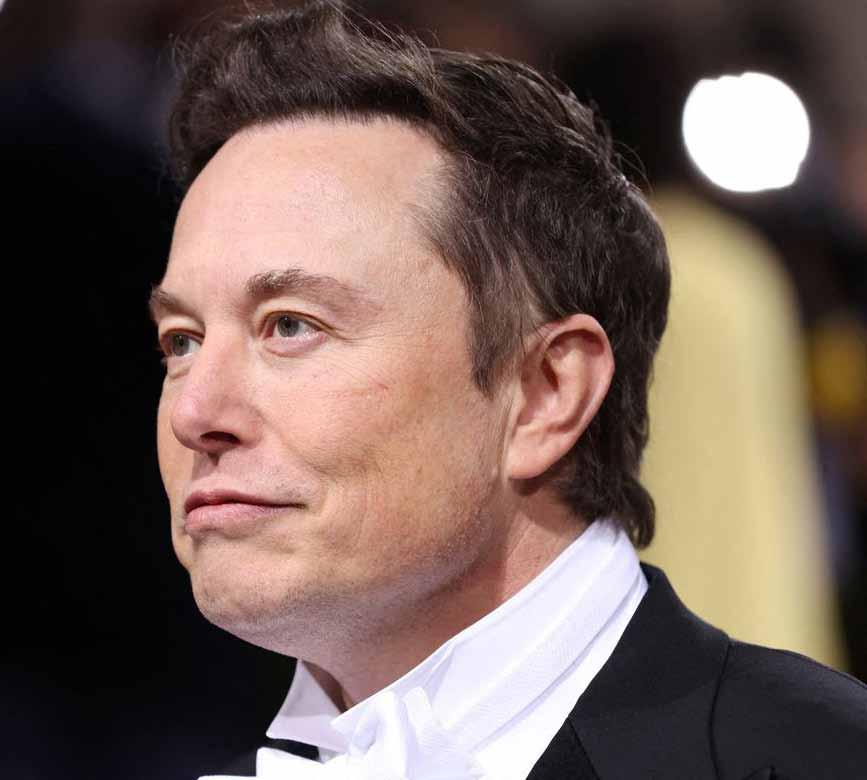
network would be quite a different story.
In the modern enterprise, strategy should be governed by the awareness that technology touches every aspect of a business led by individuals. Narrative connectivity keeps an organization agile, enabling rapid response to changes in the marketplace. As blockchain technology matures, narrative strategy will guide leaders of business and government. In the future, Elon Musk may well pursue another Twitter—but with any luck, he’ll do it with better oversight.
This article was originally published by Fast Company.
What happened to your thumb or fingers? Those versatile tools that always enabled you to skillfully button a shirt, open a jar, or tap out your thoughts on a keyboard are now stiff, hurting, and even changing shape.
Arthritis is most likely the problem, and its effects can compromise your independence. “The American College of Rheumatology has a campaign on how arthritis and other rheumatic conditions affect lives, and the symbol is a fork with twisted tines. That sums it up. Using a fork or doing any simple task can become difficult, whether it’s using your cellphone, typing, grooming, cooking, or eating,” says Dr. Jeffrey Sparks, assistant professor of medicine at Harvard Medical School and a rheumatologist at Harvardaffiliated Brigham and Women’s Hospital.
Fingers have three joints: the joint where the finger con-
nects to the hand, called the metacarpophalangeal (MCP) joint; the middle joint, called the proximal interphalangeal (PIP) joint; and the joint closest to the end of the finger, the distal interphalangeal (DIP) joint. The joint at the base of the thumb is the carpometacarpal (CMC) joint.
Two main types of arthritis affect your thumb or fingers. Symptoms depend on which type you have.
The most common type, osteoarthritis, is a degenerative problem that erodes the cushioning (cartilage) in the joints. As bones grind against each other, new bone forms, showing up as bumps (called nodes) on the joints. “These bony growths cause soft tissue around them to expand. You can get nodes in one or both knuckles, and in different fingers on either hand. Where it shows up is a bit of a mystery,” Dr. Sparks says.
In osteoarthritis, the joints most often involved are the DIP and CMC joints, and sometimes the PIP joints. These
joints can become painful, stiff, and slightly enlarged and can feel bumpy (where the little bony growths are). These symptoms can limit the motion of the fingers and thumbs. Rheumatoid arthritis (RA) is different from osteoarthritis. It is caused by an overactive immune system that (for unknown reasons) attacks the lining of the joints. Hands are a common place where RA starts, with the MCP and PIP joints most often affected. As in osteoarthritis, the joints become painful and stiff. However, in RA the joints also become quite swollen, red, and warm, reflecting the inflammation within them.
RA also commonly affects joints in the wrist, feet, ankles, elbows, shoulders, hips, knees and neck. “Often, many joints are affected, and it’s usually the same joints on both sides of the body, at the same time,” Dr. Sparks says. “Over time, the body damages the joints to point where you lose cartilage and the joints become deformed.”
In addition to joint pain, RA can cause fatigue; low-grade fever; sweating; poor appetite; difficulty sleeping; and in-
flammation of the heart, lungs, or eyes.
Several other types of arthritis can affect the fingers or thumbs, particularly two autoimmune diseases, lupus and psoriatic arthritis. “In psoriatic arthritis, the DIP joints may be involved,” Dr. Sparks says, “and there can be little pits in the fingernails.”

Another form of arthritis that affects the fingers is gout, caused by a buildup of uric acid (a waste product in the blood) that can form sharp crystals in the joints that cause inflammation. “People know about gout in the toes. It can strike the thumbs and fingers, too,” Dr. Sparks says.
Talk to your doctor if you suspect you have arthritis in your hands. Don’t put it off. “We have drugs that very effectively treat these diseases,” Dr. Sparks says. “The earlier arthritis is treated, the more likely it’s a milder course. In the case of RA, we can prevent deformities, slow disease, and avoid other complications.”
Unfortunately, we don’t have drugs to halt or slow osteoarthritis. Treatment involves controlling symptoms and improving function. “We often recommend taking oral painkillers such as acetaminophen [Tylenol], using topical painkillers such as diclofenac [Voltaren Arthritis Pain], using heat or cold therapy, and strengthening your hands,” Dr. Sparks says.
For any type of arthritis, you might benefit from wearing a splint or brace, using assistive devices (such as a shirt buttoner) that can help you with daily activities, and working with a certified hand therapist who can tailor therapy to your condition and develop work-arounds for the activities you now find challenging.
This article was originally published on Harvard Health Letter.
In addition to joint pain, RA can cause fatigue; low-grade fever; sweating; poor appetite; difficulty sleeping; and inflammation of the heart, lungs, or eyes.Credit: TNS

This intolerance is significant as Islam is the second largest religion in Europe and Britain and spreading relatively quickly in the USA. This short article will try to touch on the significant points in relation to this phenomenon (islamophobia
Every country and culture ascribes itself to a particular core value set, which in a sense, defines it. For instance, the British government defined its values as ‘democracy, the rule of law, individual liberty and mutual respect and tolerance of those with different faiths and beliefs’ the emphasis on individual liberty, mutual respect and tolerance is also seen in the US and many of the European countries. However, it seems this tolerance falls short when it comes to the Muslim community. They are sticklers for tolerance but turn into Machiavellians (whereby ends justify the means) when Islam is merely discussed. This intolerance is significant as Islam is the second largest religion in Europe and Britain and spreading relatively quickly in the USA. This short article will try to touch on the significant points in relation to this phenomenon (islamophobia).
Islamophobia seems more pronounced in countries that see themselves as a result of the Judeo-Christian tradition (European countries and the US); that is, they see themselves as the product of this religious inheritance with its implicit democratic ideals. This term which came about to eliminate discrimination against the Jews, as the respected journalist Peter Oborne stated ironically, became that which excludes Islam, the second largest religion in Europe and the world. The production of Islam as the other, the enemy, the foreigner, the existential threat, etc, has become an image that is produced in the media every time anything remotely connected to Islam occurs.
The inconsistency in European and American value judgments of Islam is evident in multiple ways. For instance, al Qaeda and the Islamic state are often seen as a product of the core teaching of Islam even if most Islamic scholars have renounced such activities as suicide techniques, killing of civilians and destruction of the environment contradict
Islamic teaching. Furthermore, most respected analysts hold the US responsible for destroying the organic institutions of society and allowing such terror to flourish during the Iraq invasion, which has now become apparent to have been initiated on false pretence. Yet when the USA or European countries commit horrendous acts such as colonialism (British settlement alone killed 100 million Indians), Hiroshima, targeting countries that do not follow their designated dictators: Cuba and Venezuela, Eritrea, Zimbabwe, Iran, eastern Congo (million dead), it is seen as just an inconsistency of liberal states. Anything atrocious that occurs and is connected to Islam is seen as an integral part of it, and a problem within its teaching, whilst anything negative about Europe or the US is just a mere anomaly, if they even admit that it was unjustifiable.
The Qatar world cup is reported as the most family and women-friendly world cup due to the lack of alcohol and conservative values, but mainstream media completely ignored such reports and decided to focus all their attention on labour abuses. “The fact of the matter is that migrant workers in the U.S. are struggling with many of the same issues those workers were facing in Qatar,” said Julie Taylor, executive director of the National Farm Worker Ministry, headquartered in North Carolina. Not to mention, western companies outsourced labour in sweatshops and whatnot. The European countries and the US seem biased and inconsistent in their value judgment, ignoring some of the same issues found in non-Muslim countries.
To conclude, the west seems to have grown to be a stickler nation preaching for democracy, the rule of law, individual liberty and mutual respect and tolerance of those with different faiths and beliefs and ironically will do anything to subjugate the other into twisted forms of these ideals even if it means going against their own set values.




























